4 Asset management follow-up
4.1 Performance of the Government Pension Fund Global
4.1.1 Market developments in 2013
A broad upturn in developed markets characterised the world stock market in 2013. Higher interest rates resulted in a bond market return of close to zero. An important event in the first quarter was the interim budget compromise in the US, which was followed by a stock market surge. Economic data from the Euro zone were weak throughout the quarter, and sovereign debt concerns resurfaced in March with the request for an anti-crisis package from the Cypriot authorities.
In April, the Japanese central bank announced that it would engage in significant quantitative easing to stimulate economic growth. This resulted in Japanese equities rebounding steeply. In May, markets reacted negatively to a statement from the Fed Chair that the Federal Reserve might reduce its bond purchases in 2013. Risky assets were divested and long-term US interest rates increased considerably. The Japanese stock market slumped by close to 20 percent. In China, the financial market liquidity situation worsened in June when the Chinese central bank attempted to control credit growth. The Euro zone did, at the same time, show signs of improvement. All in all, broad global equity indices gained somewhat in the second quarter. However, broad emerging market indices went into steep decline in the second quarter, after poor performance in the first quarter as well. Fixed income indices depreciated, like in the first quarter.
In the third quarter, the Euro zone countries as a group emerged from their longest ever recession, after six consecutive quarters of negative growth. Growth was strongest in Germany and France, whilst the more peripheral Euro zone countries were still faced with GDP contractions. In September, the US Federal Reserve surprised markets by not cutting back on quantitative easing. That resulted in bond markets breaking with the declining price trend of the two preceding quarters, and broad fixed income indices appreciated. Global stock markets also gained in the third quarter. Emerging markets contributed to the upsurge after the Chinese interbank market showed signs of stability.
In the US, the third and fourth quarters were turbulent as the result of continued federal budget discord in Congress, especially with regard to raising the debt ceiling (the national debt cap adopted by Congress). A two-year agreement that also encompassed the debt ceiling was concluded in December, and is considered one of the reasons why the Federal Reserve announced, in that same month, that it would start scaling back quantitative easing. The US Federal Reserve also communicated that short-term interest rates will be kept low for quite some time. The events in the US served, together with more good economic news from the Euro zone, to overshadow the turbulence in the Chinese interbank market, which flared up briefly again in December. Bond markets contracted as the result of the news from the US Federal Reserve, and 10-year US treasury bond yields increased to 3 percent. News of the scaling back was well received by the stock markets, which gained in the fourth quarter. Emerging economy stock markets appreciated in the fourth quarter, but the recoupment was not large enough to prevent a weak year for equity investments in these countries as a whole.
4.1.2 The market value of the Fund
At yearend 2013, the market value of the Government Pension Fund Global (GPFG) was NOK 5,038 billion. Developments in stock market values resulted in the portion of equities in the benchmark index exceeding 64 percent as at the end of September 2013. Hence, the equity portion of the benchmark index was rebalanced to 60 percent as at the end of the following month, in line with the provisions of the mandate laid down by the Ministry. At yearend, the assets of the actual portfolio comprised NOK 3,107 billion in equities, NOK 1,879 billion in bonds and NOK 52 billion in real estate, cf. figure 4.1.
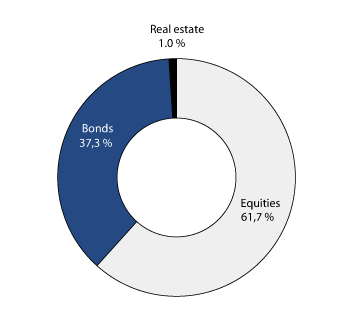
Figure 4.1 Distribution of the actual investments of the GPFG by asset classes at yearend 2013. Percent
Source Norges Bank.
The market value of the Fund increased by NOK 1,222 billion during the course of 2013. Figure 4.2 shows the change in the Norwegian kroner market value of the Fund in 2013 and since its inception in 1996, split into capital inflows, returns, changes in the Norwegian kroner exchange rate, as well as asset management costs. Total capital inflow since inception is NOK 3,299 billion, whilst the total return, net of the Norges Bank asset management costs, is NOK 1,775 billion. Figure 4.3 shows fund value developments since inception.
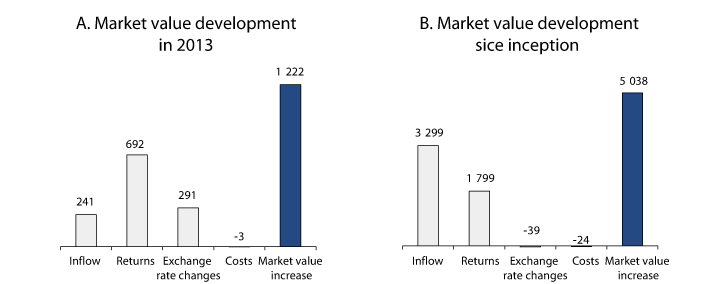
Figure 4.2 Developments in the market value of the Fund in 2013 and since inception of the Fund in 1996. NOK billion
Source Norges Bank and the Ministry of Finance.
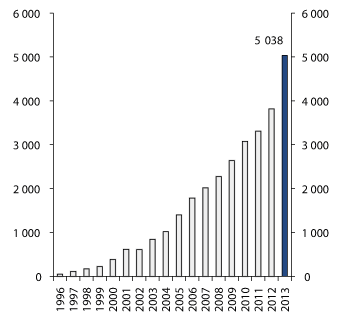
Figure 4.3 Developments in the market value of the GPFG since inception. NOK billion
Source Norges Bank.
In 2013, the inflow to the Fund was NOK 241 billion. Just over NOK 2 billion of such inflow was used to cover the costs of Norges Bank in managing the GPFG in 2012. About 62 percent of the remainder was invested in equities. A further 30 percent was invested in bonds, whilst real estate accounted for 8 percent. About 8 percent of the capital inflow in 2013 was invested in emerging markets. This amounts to about NOK 19 billion.
At yearend 2013, 58 countries were approved as market places where the Fund can trade in equities. That was six more than at the beginning of the year. New market places were Kuwait, Oman, Tunisia, Vietnam, Slovakia and Pakistan. At yearend, about 10 percent of the equity holdings were invested in emerging markets. The Fund also made its first investments in the local government bond markets in Colombia, the Philippines and Hungary in 2013. According to figures from Norges Bank, about 12 percent of the fixed income portfolio was invested in emerging markets at yearend, as compared to 10 percent at the beginning of the year.
At yearend 2013, the Fund held an average ownership stake of about 1.3 percent in global stock markets, as defined by the index provider FTSE. The average ownership stake was somewhat larger in emerging markets than in developed markets. Ownership stakes in global bond markets were about 0.9 percent, cf. figure 4.4.
During 2013, the Fund acquired new real estate in the US and Europe valued at just over NOK 22 billion. The real estate was principally in the form of office properties, shopping centres and logistics properties. In addition to the said investments, the Fund concluded agreements for the acquisition of an office property and a number of logistics properties in the US at the end of 2013. These transactions will be completed in 2014.
External management
At yearend 2013, 3.8 percent of the GPFG was managed by external managers. That was the same portion as one year earlier. 96.2 percent of the Fund is managed internally by Norges Bank. External management predominantly involves equity mandates in emerging markets and small companies in developed markets. These are markets and segments where Norges Bank does not deem it appropriate to develop internal expertise, whilst the Bank believes that prospects are good for outperforming the general market.
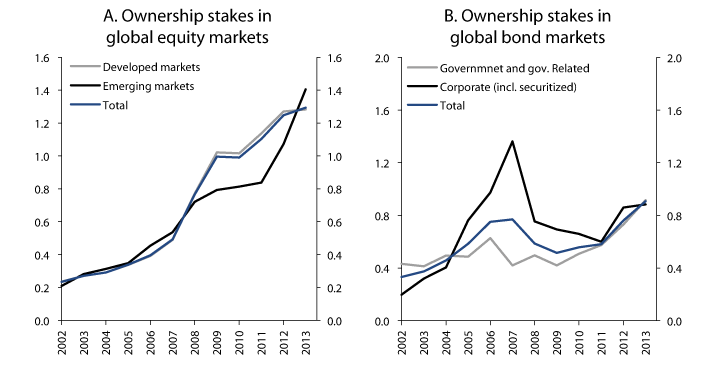
Figure 4.4 Ownership stakes of the GPFG in global stock and bond markets. Percent
Source Norges Bank.
4.1.3 Return
Reporting of the return on fund assets is focused on developments measured in the currency basket of the Fund, cf. box 4.1 and the discussion in section 4.2. The investments of the GPFG seek to maximise international purchasing power, given a moderate level of risk. Changes in the Norwegian kroner exchange rate may in some years have a major impact on fund value measured in Norwegian kroner, but do not affect the international purchasing power of the Fund. All return data in this section are measured in the currency basket of the Fund, unless otherwise specified.
The overall portfolio
The GPFG registered an aggregate return of 15.9 percent in 2013, before the deduction of asset management costs, cf. table 4.1. This was the second best performance in the history of the Fund, cf. figure 4.5. This favourable outcome reflects strong stock market performance, whilst bond market returns were close to zero. Positive returns have been generated in 12 out of 16 years since 1998, with only one year of significant negative returns (2008). Appendix 1 to this report presents returns measured in Norwegian kroner and certain other currencies. In 2013, the return on the GPFG measured in Norwegian kroner was 25.1 percent. Since 1 January 1998, the average annual return on the GPFG has been 5.7 percent measured in the currency basket of the Fund, whilst the return in Norwegian kroner has been 5.5 percent. The annualized return was 6.8 percent measured in US dollars.
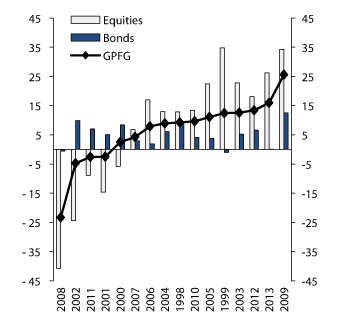
Figure 4.5 Annual nominal returns on the GPFG, ranked from lowest to highest return. Measured in the currency basket of the Fund and before asset management costs. Percent
Source Norges Bank and the Ministry of Finance.
Textbox 4.1 Return measured in the currency basket of the Fund and in Norwegian kroner
GPFG assets account for the majority of State financial savings. The Norwegian kroner value of the Fund is therefore of relevance to State finances when taken in isolation. The fiscal policy guideline is, for example, based on the premise that transfers from the GPFG to the fiscal budget correspond to four percent of the Norwegian kroner value of the Fund. However, the Norwegian kroner value of the Fund is of less relevance to Norway as a nation.
Oil and gas sales leave Norway with a considerable trade surplus. A major part of this surplus accrues to the State, most of which is saved through the GPFG. Hence, the Fund plays an important role in national savings.
Oil and gas sales generate foreign currency revenues for Norway. The foreign currency revenues are reinvested in international currency equities, bonds and real estate through the transfers to the GPFG. A major part of the petroleum revenues is not converted into Norwegian kroner. The foreign currency revenues of the State from SDFI (the State’s Direct Financial Interest) are, for example, transferred directly to Norges Bank, which then invests these revenues in the Fund.
In a national perspective, the savings held in the GPFG shall finance future purchases of goods and services produced internationally – i.e. future imports. The quantity of foreign goods and services that may be financed by the fund capital depends on the fund value measured in international currency, and not on its value measured in Norwegian kroner. Hence, the investments of the Fund seek to maximise international purchasing power, given moderate risk.
Consequently, the main emphasis is on reporting the return on the Fund measured in international currency, despite the financial statements of the GPFG being prepared in Norwegian kroner. No single currency is appropriate for reporting such return, cf. the discussion in section 4.2. A basket comprising several currencies is used instead. The currency basket of the Fund is a weighted combination of the currencies included in the benchmark indices for the equity and fixed income investments of the Fund; currently a total of 34 currencies.
Equities
The equity portfolio achieved a return of 26.3 percent last year. The equity investments held by the Fund in North America, Europe and Japan achieved a return of about 30 percent. Emerging markets delivered a weaker return of about 1 percent, but with major return differences between countries. Countries with large balance of payment deficits saw capital outflows, which resulted in weak performance of the respective stock markets.
All equity sectors delivered positive returns in 2013. The telecommunications sector generated the highest sector return, with a 37.5 percent return on the investments of the Fund. The health sector delivered the second best sector performance, registering a return of 35.0 percent. Expectations of slower growth in China resulted in weaker demand for commodities. This influenced developments in the materials sectors, which registered the weakest sector performance with a return of 5.1 percent.
Bonds
The return on the fixed income portfolio in 2013 was 0.1 percent. Government bond yields increased through 2013, from very low levels at the beginning of the year, cf. figure 4.6. Increasing yields entail declining bond prices, thus reducing overall returns on bonds. Government bonds accounted for more than 60 percent of the fixed income investments, and registered a return of -2.3 percent in 2013. Inflation-linked bonds delivered the weakest sector performance, with a return of -3.0 percent. However, these only accounted for a minor part of the fixed income investments of the Fund. Corporate bonds delivered a return of 2.1 percent, whilst bonds issued by government-related companies generated a return of 1.9 percent. Securitised bonds delivered the strongest performance, with a return of 7.7 percent. The securitised bonds are principally denominated in euros. Euros appreciated relative to the currency basket in 2013, which contributed to the high return on these bonds as measured in the currency basket.
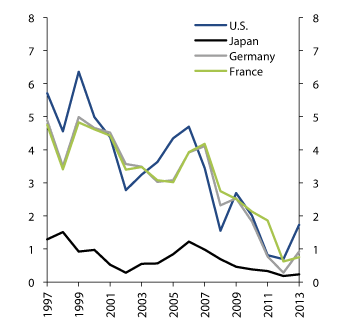
Figure 4.6 Yields on 5-year government bonds from selected countries. Percent
Source Macrobond.
At yearend 2013, the average effective yield on bonds held by the Fund was 2.4 percent, with a duration of 5.1 years. Duration is a measure for the average time until an investor can expect to receive the entire cash flow from a bond. A fixed income portfolio with a long duration will be more sensitive to yield changes than a portfolio with a short duration. At yearend, the duration of the Fund was somewhat less than that of the benchmark index, thus implying that the actual portfolio of the Fund was somewhat less exposed to yield increases, in relative terms, than the benchmark index.
Real estate
The overall real estate investment return in 2013 was 11.8 percent, measured in the currency basket of the Fund. Net rental income was 4.6 percent. Changes in the value of properties and associated debts contributed 3.8 percentage points to the overall return. Transaction costs for real estate purchases reduced the return by 0.4 percentage points. The return on each property is measured in local currency. The overall return on the real estate portfolio is, however, measured in the currency basket of the GPFG. The real estate portfolio is in an establishment phase, and has thus far been concentrated in three currencies (euros, US dollars and pound sterling). Exchange rate changes may therefore have a major impact on returns as measured in the currency basket of the Fund. In 2013, exchange rate changes increased the return on the real estate portfolio by about 3.8 percentage points.
It takes a long time for index providers to prepare return data for unlisted real estate. The United Kingdom is amongst the first markets in Europe for which return data are available, and data from the index provider IPD show that returns in the UK market were slightly below 11 percent in 2013, as measured in pound sterling. In the other European countries for which the index was available by the end of March, the average return was slightly above 4 percent, measured as a weighted average of local currency returns. On the whole, real estate values in Europe have declined somewhat in 2013. Current rent income nonetheless ensured a positive overall return. The return on the IPD US real estate index was just over 11 percent in 2013, as measured in dollars.
The Ministry of Finance has commissioned an annual report from IPD on real estate investment returns in the GPFG. The most recent report shows that the return on the real estate portfolio of the GPFG in 2012 somewhat exceeded that of an index including the European countries in which IPD is represented, with the exception of Norway. In 2012, the real estate portfolio of the GPFG comprised a relatively small number of properties in Europe, and hence the informational value of the index comparison is limited. The report is available on the Ministry website (www.government.no/gpf).
The real estate investments made by Norges Bank comply with international environmental standards for real estate development and reporting. Analyses of potential real estate investments include an assessment of environmental factors. Measures aimed at improving the efficiency of energy and water consumption, as well as waste handling, are addressed in the ongoing dialogue between Norges Bank and its cooperation partners.
Norges Bank is a member of Global Real Estate Sustainability Benchmark (GRESB), a reporting tool for real estate companies. In 2013, all the cooperation partners of Norges Bank reported environmental information to GRESB.
Norges Bank makes use of subsidiaries when investing in real estate, in order to limit and clarify risk and liability. This is in line with market practice and supports the Bank’s objective of safeguarding the financial interests of the Fund through sound risk management. The incorporation of subsidiaries enables financial liability to be limited to the capital of the relevant subsidiary.
Norges Bank shall, under the mandate for the GPFG, seek to maximise the return net of costs. Taxes may in some cases be an important cost component. Norges Bank notes, in its annual report on the management of the GPFG in 2011, that it is important for the investments to be taxed correctly in compliance with local regulations, whilst also ensuring that the Fund does not incur larger tax costs than are necessary. See also the discussion in Report No. 16 (2007–2008) to the Storting – The Management of the Government Pension Fund in 2007.
Norges Bank has incorporated subsidiaries in Luxembourg, which make and follow up on the real estate investments in Continental Europe, cf. Report No. 17 (2011–2012) to the Storting – The Management of the Government Pension Fund in 2011. For the US real estate investments, Norges Bank has incorporated companies in Delaware. The choice of these jurisdictions is based on a number of considerations, such as predictable and robust legal frameworks and their general use by international institutional investors. Local tax regulations and bilateral tax treaties are also important in this context.
The agreements and corporate documents established by the Bank ensure access to relevant information about the subsidiaries for the Supervisory Council, the internal audit unit of the Bank and the external auditor of the Bank.
Equity and fixed income investment performance
Equities are expected to generate higher returns than bonds over time. Since 1998, the Fund has experienced high bond returns as the result of declining bond yields. The market has been through two periods of steep equity price slumps over the same period, both in 2000 when prices declined after the bursting of the dot-com bubble and during the financial crisis in 2008. On the whole, equities were therefore outperformed by bonds over the period from January 1998 to December 2012, inclusive. The return differences between equities and bonds in 2013 meant that equities outperformed bonds in terms of overall returns since 1998, as at yearend 2013. This applies to both the benchmark indices of the Fund, cf. figure 4.7, and the actual return on the Fund, cf. figure 4.8.
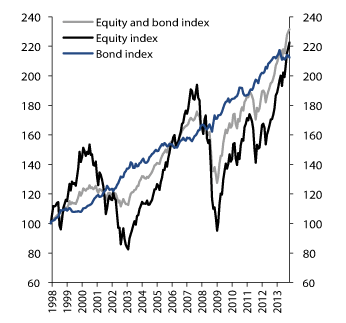
Figure 4.7 Developments in the benchmark indices of the GPFG. Index. 31 December 1997 = 100
Source Norges Bank and the Ministry of Finance.

Figure 4.8 Return on the equity and fixed income portfolios of the GPFG over time, measured in the currency basket of the Fund. Percent
Source Norges Bank and the Ministry of Finance.
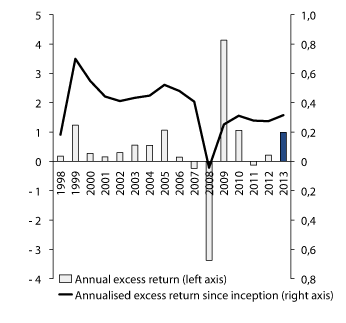
Figure 4.9 Gross excess return performance of the GPFG over time. Percent
Source Norges Bank and the Ministry of Finance.
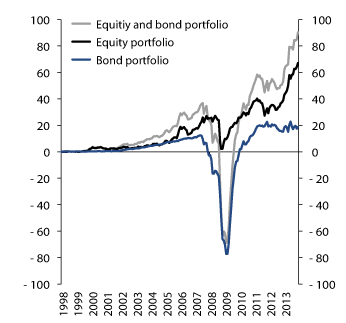
Figure 4.10 Accumulated excess return on the GPFG, 1998–2013. NOK billion
Source Norges Bank and the Ministry of Finance.
As at yearend 2013, the return on equities had contributed more than 2/3 of the overall return on the Fund since 1996. Equity investment returns accounted for NOK 1,242 billion, whilst bond returns represented NOK 551 billion. Overall real estate returns accounted for NOK 5 billion.
Relative return
The return on the investments of the Fund is compared to the return on the benchmark index defined by the Ministry. All in all, Norges Bank achieved a return before the deduction of costs in 2013 that outperformed the benchmark index by 1.0 percentage point. The equity portfolio outperformed the benchmark index by 1.3 percentage points. The Ministry has estimated the gross excess return on the equity portfolio in 2013 at about NOK 28 billion.1
Investments within the finance and consumer goods sectors generated the greatest positive contribution to the excess return. Health sector investments delivered the largest negative contribution. In geographical terms, equities in the US and Germany contributed most to the positive excess return, whilst equities in Spain and Canada delivered the most negative contributions.
The fixed income investments of the Fund outperformed the benchmark index by 0.2 percentage points, which corresponds to about NOK 3 billion. The average duration of bonds held by the Fund was somewhat lower than that of the bonds in the benchmark index. The fixed income portfolio of the Fund was therefore less affected by yield changes, and declined less in value than the benchmark index as the result of increasing yields over the year. Overweighting in covered bonds denominated in euro also made a positive excess return contribution. Overweighting in emerging market government bonds made a negative excess return contribution.
Since 1 January 1998, Norges Bank has achieved an average gross annual excess return of 0.31 percentage points, cf. figure 4.9. This is slightly higher than the expectation previously signalled by the Ministry, given the exploitation of the scope for deviations from the equity and fixed income benchmarks, cf. Report No. 10 (2009–2010) to the Storting. The Ministry has estimated the total gross excess return on the Fund for the period from January 1998 to December 2013 at about NOK 90 billion, cf. figure 4.10.
Real return
The return on the GPFG in 2013 after the deduction of asset management costs and inflation (net real return) was 14.3 percent, cf. figure 4.11. The average annual net real return over the period from January 1997 to December 2013 was 3.9 percent. Measured from January 1998, the average annual net real return was 3.6 percent. This is 0.7 percentage points higher than the corresponding figure at yearend 2012.
Table 4.1 Return on the GPFG in 2013, the last 3, 5 and 10 years, as well as over the period 1998–2013, measured in the currency basket of the Fund and before the deduction of asset management costs. Annual geometric average. Percent
Last year | Last 3 years | Last 5 years | Last 10 years | 1998–2013 | |
|---|---|---|---|---|---|
GPFG incl. real estate | |||||
Actual portfolio | 15.95 | 8.62 | 12.03 | 6.30 | 5.70 |
Inflation | 1.39 | 2.07 | 2.00 | 2.14 | 1.89 |
Management costs | 0.07 | 0.07 | 0.09 | 0.10 | 0.09 |
Net real return | 14.29 | 6.35 | 9.74 | 3.98 | 3.65 |
GPFG excl. real estate | |||||
Actual portfolio | 15.97 | 8.64 | 12.04 | 6.31 | 5.70 |
Benchmark index | 14.98 | 8.31 | 10.88 | 6.07 | 5.39 |
Excess return | 0.99 | 0.33 | 1.16 | 0.24 | 0.31 |
Equity portfolio | |||||
Actual portfolio | 26.28 | 10.77 | 15.64 | 7.81 | 5.66 |
Benchmark index | 24.99 | 10.42 | 14.96 | 7.33 | 5.13 |
Excess return | 1.28 | 0.34 | 0.69 | 0.49 | 0.53 |
Fixed income portfolio | |||||
Actual portfolio | 0.10 | 4.55 | 6.01 | 4.41 | 5.03 |
Benchmark index | -0.15 | 4.39 | 4.17 | 4.20 | 4.82 |
Excess return | 0.25 | 0.16 | 1.83 | 0.21 | 0.21 |
Real estate portfolio | |||||
Actual portfolio | 11.79 | 4.571 |
1 Since 1 April 2011.
Source Norges Bank and the Ministry of Finance.
4.1.4 Risk and limits
Fund risk
Standard deviation is a statistical measure of risk. Standard deviation can, under the simplified assumption that return data follow a normal distribution over time, be used to indicate the expected normal volatility of annual fund returns, measured in the currency basket of the Fund. Norges Bank has estimated the expected standard deviation at yearend 2013 at 9.3 percentage points, or about NOK 470 billion at a fund size of NOK 5,038 billion. Fluctuations will fall outside the said range in one out of three years. Historically, volatility has exceeded that implied by the normal distribution assumptions.
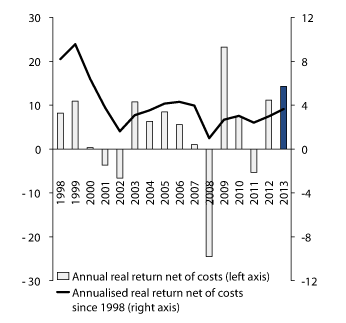
Figure 4.11 Real return on the GPFG over time, measured in the currency basket of the Fund. Percent
Source Norges Bank and the Ministry of Finance.
Figure 4.12 shows how the realised standard deviation of the GPFG benchmark indices has developed since 1998. The figure reflects the standard deviation at any given time as computed on the return over the preceding 12 months. The figure shows that risk measured in this way has varied considerably over time. During periods of major market turbulence, such as during the financial crisis in 2008–2009, the risk as measured by the standard deviation has been significantly higher than for the entire period as a whole. In 2013, risk declined in the first half of the year, but increased again in the second half. At yearend, the overall risk of the Fund was about the same level as at the beginning of the year. Stock market developments have the most impact on the overall risk of the Fund.
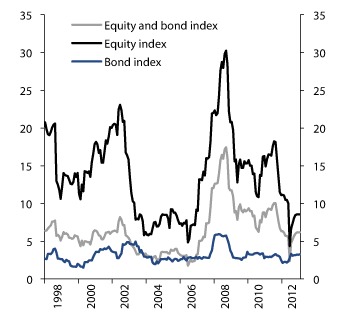
Figure 4.12 Developments in the 12-month rolling standard deviation of the GPFG benchmark indices. Percentage points
Source Norges Bank and the Ministry of Finance.
As at yearend 2013, bond risk over the last 12 months was around the historical average for the period 1998–2013. Equity risk was low when compared to historical developments in figure 4.12 and the long-term expectation of the Ministry.
Relative risk
The mandate for the GPFG stipulates limits defining the extent to which Norges Bank may, in its asset management, deviate from the benchmark index as measured by expected tracking error. The purpose of such deviations is to achieve a higher return than the benchmark index by exploiting weaknesses in the index and opportunities in the market, as well as the characteristics of the Fund. The mandate stipulates a number of supplementary risk measures, thus defining a risk management framework.
Expected tracking error is a statistical measure as to how much the actual return on the Fund can be expected to deviate from the return on the benchmark index. The mandate for the GPFG stipulates that Norges Bank shall organise asset management with a view to preventing expected tracking error from exceeding 1 percentage point. If one assumes that the return deviations follow a normal distribution, this means that one can in two out of three years expect the return on the Fund to deviate by less than 1 percentage point from the return on the benchmark index. In one out of three years one must expect such deviations to exceed 1 percentage point. The Ministry has emphasised that the expected tracking error may, under extraordinary circumstances, be higher without representing a violation of the mandate. The method for calculating expected tracking error is determined by Norges Bank and approved by the Ministry. According to Norges Bank, the estimated expected tracking error during 2013 was well below 1 percentage point, and was calculated to be 0.6 percentage point at yearend.
The limit on deviations from index applies to expected future deviations. In retrospect, it may be useful to compare this to the actual deviations. Figure 4.13 shows tracking error based on actual deviations between the return on the Fund and the return on the benchmark index. At any given time in the figure, tracking error is computed on the basis of the excess return over the preceding 12 months. As at yearend 2013, the realised tracking error over the preceding 12 months was 0.4 percentage points; somewhat lower than the current expectations of Norges Bank.
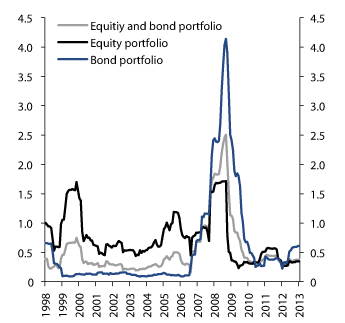
Figure 4.13 Rolling 12-month realised tracking error of the equity and fixed income portfolios of the GPFG, as well as of the Fund as a whole. Percentage points
Source Norges Bank and the Ministry of Finance.
Situations may arise in which actual return deviations between the benchmark index and the actual portfolio exceed those implied by expected tracking error. One reason for this is that tracking error does not capture all types of risk that may arise in asset management. An example of this is provided by the experience from 2008 and 2009.
Figure 4.14 shows developments in the standard deviation of the Fund and of the benchmark index, based on returns in rolling 12-month periods. The risk in the Fund has been more or less on a par with the risk in the benchmark index during most of the period since 1998. An exception was registered during and after the financial crisis in 2008, when the risk in the Fund was higher than that of the benchmark index. The figure illustrates that it is predominantly the risk in the benchmark index that determines the overall risk in the Fund, whilst Norges Bank’s deviations from the benchmark index only make a minor contribution. This is in line with the conclusions in the report from Ang, Brandt and Denison, cf. the discussion in section 2.2. The risk in the Fund, as measured in this way, has been somewhat higher than the risk in the benchmark index during 2013.
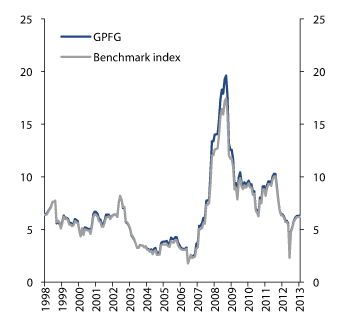
Figure 4.14 Rolling 12-month standard deviation of the actual portfolio of the GPFG vs. the benchmark index. Percentage points
Source Norges Bank and the Ministry of Finance.
The excess return that Norges Bank is able to generate through its management of the GPFG depends on, inter alia, the limit on deviations from the benchmark index. The ratio between the achieved excess return and tracking error is called the information ratio, and expresses the risk-adjusted excess return on investments. With an expected excess return of about ¼ percentage points, and expected tracking error of less than 1 percent, the expected information ratio over time should be somewhat above ¼. Norges Bank achieved an information ratio of just above 0.4 over the period 1998–2013. The information ratio of the equity portfolio was about 0.6 over the same period, whilst that of the fixed income portfolio was just below 0.2; see table 4.2. The calculated information ratios show that Norges Bank has achieved an excess return somewhat higher than the expected ¼ percentage points, whilst the measured relative risk has been below the 1-percent limit. This results in a risk-adjusted excess return that is better than expected.
Table 4.2 Absolute and relative risk measures for the GPFG, monthly observations. January 1998–December 2013
Last year | Last 3 years | Last 5 years | Last 10 years | 1998–2013 | |
|---|---|---|---|---|---|
GPFG excl. real estate | |||||
Absolute volatility (percentage points) | 6.31 | 7.27 | 9.01 | 8.54 | 7.67 |
Tracking error (percentage points) | 0.38 | 0.37 | 0.68 | 0.90 | 0.75 |
Skewness1 | -1.08 | -0.60 | -0.20 | -1.08 | -0.96 |
Kurtosis2 | 4.04 | 3.11 | 2.83 | 6.85 | 6.77 |
Information ratio3 | 2.62 | 0.90 | 1.70 | 0.27 | 0.42 |
Equity portfolio | |||||
Absolute volatility (percentage points) | 8.76 | 12.39 | 15.05 | 14.81 | 15.63 |
Tracking error (percentage points) | 0.35 | 0.43 | 0.41 | 0.80 | 0.85 |
Skewness | -0.98 | -0.70 | -0.22 | -0.97 | -0.80 |
Kurtosis | 3.92 | 3.91 | 3.22 | 5.57 | 4.32 |
Information ratio | 3.71 | 0.81 | 1.68 | 0.61 | 0.62 |
Fixed income portfolio | |||||
Absolute volatility (percentage points) | 2.95 | 2.67 | 3.42 | 3.55 | 3.48 |
Tracking error (percentage points) | 0.61 | 0.45 | 1.36 | 1.42 | 1.13 |
Skewness | -0.31 | -0.33 | -0.08 | -0.46 | -0.41 |
Kurtosis | 1.91 | 2.71 | 3.21 | 4.57 | 4.11 |
Information ratio | 0.41 | 0.37 | 1.35 | 0.15 | 0.19 |
1 Skewness is a measure of the asymmetry in the distribution of returns. A positive skewness implies that there are more very high values than very low values compared to the median value, and vice versa.
2 Kurtosis is a measure of how likely it is that extreme positive or negative values will occur. A value in excess of 3 indicates that extreme values occur more often than under the normal distribution.
3 Information ratio (IR) is a risk-adjusted measure expressing how much excess return a manager has achieved as measured against the active risk (tracking error).
Source Norges Bank and the Ministry of Finance.
Credit risk
All the bonds included in the benchmark index of the GPFG have been accorded a credit rating2 by at least one of the leading rating agencies. The purpose of credit ratings is to indicate how likely it is that the borrower will be able to meet the interest costs and repay the loan. The portion of bonds with a credit rating of A or weaker at yearend 2013 was 29 percent. This is the same level as at yearend 2012.
Bonds with low credit ratings, so-called high-yield bonds, are not included in the benchmark index of the GPFG. Norges Bank may nevertheless invest in such securities within the defined management limits. The Ministry has stipulated that the asset management shall be organised with a view to ensuring that such bonds do not represent more than 5 percent of the market value of the fixed income portfolio. This also ensures that Norges Bank does not have to sell fixed income instruments that are downgraded. At yearend 2013, Norges Bank reported that the portion of bonds classified as high-yield bonds was 0.6 percent, as compared to 0.7 percent at the beginning of the year.
Individual investments
The growth of the Fund in recent years has resulted in increased ownership stakes in a number of companies. At yearend 2013, the Fund held ownership stakes of more than 2 percent in 1,088 companies, up from 891 at yearend 2012. The number of companies in which the Fund held ownership stakes of more than 5 percent increased to 45, up from 34 at the beginning of the year.
The role of the Fund is to be a financial investor. It seeks to diversify risk in the best possible manner. The Ministry has therefore stipulated that the Fund can hold a maximum of 10 percent of the voting shares of any one company. At yearend 2013, its largest ownership stake in one single company was 9.4 percent. The market value of the largest investment of the Fund in one single company at yearend 2013 was NOK 39 billion.
At yearend 2013, the Fund held equities of 8,213 companies, up from 7,427 companies one year earlier.
Limits defined by Norges Bank
In addition to the abovementioned requirements, the Executive Board of Norges Bank shall define further limits in order to manage and curtail the risk in the management of the GPFG. Any changes to the supplementary risk limits shall be presented to the Ministry before entering into effect. Table 4.3 shows the limits defined by the Executive Board for various risk categories, as well as the actual levels as per yearend 2013.
Table 4.3 Limits applicable to the management of the GPFG, laid down by the Executive Board of Norges Bank
Risk | Limits | Actual utilisation as per 31 December 2013 (percent) |
|---|---|---|
Counterparty risk1 | Maximum 0.5 percent for any one counterparty | 0.1 |
Credit risk2 | Any one issuer of bonds with a credit rating below BBB- can represent a maximum of 1 percent of the fixed income investments | 0.1 |
Overlap3 between actual holdings and benchmark index | Equities: minimum 60 percent Bond issuers: minimum 60 percent | 81.1 74.0 |
Liquidity requirement for the Fund, excl. real estate | Minimum 10 percent in government bonds issued by the US, the UK, Germany, France and Japan | 14.9 |
Leverage | Maximum 5 percent of the equity and fixed income investments | 0.1 |
Securities lending | Maximum 35 percent of the Fund | 3.3 |
Issuance of options | Maximum 2.5 percent of the Fund | 0.0 |
Securities borrowing through borrowing programmes | Maximum 5 percent of the Fund | 0.0 |
Investment in any one company | Maximum 1.5 percent of the Fund | 0.8 |
Assets managed by any one external management organisation | Maximum 1 percent of the Fund | 0.2 |
1 Counterparty risk is the risk that a bank or other contracting party is unable to meet its obligations, such as for example paying the value of a derivatives contract upon settlement.
2 Credit risk is the risk of a borrower being unable to fulfil its legal obligations, like for example the payment of accrued interest or the repayment of principal.
3 Overlap shows what portion of the actual portfolio is identical to the benchmark index. If overlap is 100 percent in the equity portfolio, the actual portfolio comprises the same companies as the benchmark index and each company accounts for the same portion of the actual portfolio as of the benchmark index. If the actual portfolio comprises other companies than the benchmark index, or is over- and underweighted in certain companies, the overlap will be less.
Source Norges Bank.
Real estate investment limits
The mandate for the management of the GPFG stipulates that up to 5 percent of the Fund value shall be invested in real estate over time. The Fund made its first real estate investment in 2011, and Norges Bank is required to spread the expansion of these investments over several years. In addition, the Executive Board of Norges Bank is required to impose additional limits to curtail the real estate investment risk, cf. table 4.4. In addition to the limits in table 4.4, the Executive Board has stipulated that a maximum of 2 percent of the Fund can be invested in real estate in any one year.
Table 4.4 Limits applicable to the GPFG real estate investments, laid down by the Executive Board of Norges Bank
Risk | Limits | Actual utilisation as per 31 December 2013 (percent) |
|---|---|---|
Country distribution | France, Germany and the UK: Up to 35 percent of the strategic real estate allocation for the Fund Other countries: Up to 10 percent of the strategic real estate allocation for the Fund | 7.2 2.8 |
Sector distribution | Office premises: 0-60 percent of the strategic real estate allocation for the Fund Retail premises: 0-60 percent of the strategic real estate allocation for the Fund Other real estate: 0-30 percent of the strategic real estate allocation for the Fund | 13.1 5.0 4.6 |
Emerging market real estate investments | Maximum 10 percent of the strategic real estate allocation for the Fund | 0.9 |
Investments in real estate under development | Maximum 15 percent of the real estate investments | 4.3 |
Investments in unoccupied real estate | Maximum 15 percent of the real estate investments | 5.0 |
Investments in interest-bearing instruments | Maximum 25 percent of the strategic real estate allocation for the Fund | 0.0 |
Investments in listed real estate equities | Maximum 25 percent of the strategic real estate allocation for the Fund | 0.0 |
Debt-equity ratio | Maximum 50 percent of the real estate investments Maximum 70 percent for each investment | 11.0 53.3 |
Source Norges Bank.
Systematic risk factors
Norges Bank shall, according to the mandate for the GPFG, seek to organise asset management to ensure that the return on active positions is exposed to several different systematic risk factors. One example of such a risk factor is company size. The value of small company equities has developed differently from, and over long time horizons better than, the value of large company equities. Size is measured as the market value of the company’s equities. Another example is value. Equities of companies with low valuations (value equities) have delivered different, and over long time horizons better, returns than equities with high valuations. Valuation is measured by the market value of company equities relative to fundamentals like the company’s book value of equity, profits, sales or dividends. How exposed the Fund is to such factors can be analysed by comparing the excess return on the Fund to the return from such factors.
Figure 4.15 shows the findings from such an analysis of the equity portfolio carried out by Norges Bank. The analysis indicates that the equity portfolio has over the last two years been more exposed to small company developments than has the benchmark index. The equity portfolio has also been more exposed to market developments than has the index. The other factors register minor impacts only. What portion of the excess return volatility can be explained by the model varies over time. According to Norges Bank, the risk factors used in the analysis explain about 20 percent of the excess return volatility of the equity portfolio in 2013. Hence, the findings generated by the model are subject to uncertainty.
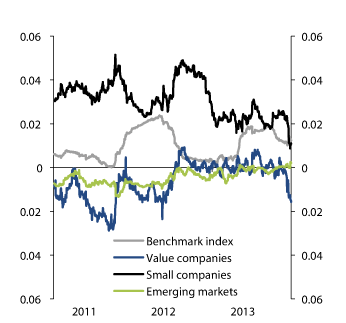
Figure 4.15 Systematic risk factors in the GPFG equity portfolio. Coefficients
Source Norges Bank.
Figure 4.16 presents an analysis of systematic risk factors in the fixed income portfolio. The analysis indicates that the fixed income portfolio was, towards the end of 2012 and throughout 2013, less exposed to increasing bonds yields than was the benchmark index (the Fund was underweighted in the term premium). This implies that the Fund will depreciate less, in relative terms, than the benchmark index when yields increase, but also that the Fund will appreciate less in the event of falling yields. The analysis is unable to uniformly establish whether the credit risk in the fixed income portfolio is higher or lower than that in the benchmark index. This would appear to vary over time. According to Norges Bank, the model can only explain a minor part (about 30 percent) of the excess return volatility in 2013.
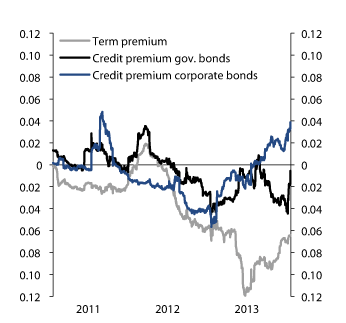
Figure 4.16 Systematic risk factors in the GPFG fixed income portfolio. Coefficients
Source Norges Bank.
4.1.5 Costs
The mandate given by the Ministry to Norges Bank implies that the actual management costs of the Bank are covered up to an upper limit, which for 2013 was fixed at 0.09 percent (9 basis points) of the average market value of the Fund. In addition, Norges Bank is compensated for performance fees to external managers.
Asset management costs, excluding performance-based fees for external managers, amounted to NOK 2.2 billion in 2013. This corresponds to 0.05 percent of the average market value of the Fund, down from 0.053 the previous year.
Overall asset management costs increased to NOK 2.9 billion in 2013, from NOK 2.2 billion in 2012. Higher fees to external managers as the result of higher excess returns were the main reason for such increase, cf. figure 4.17. In addition, the minimum fees of external managers increased as the result of the increase in assets under management. Custodianship costs are partly dependent on fund assets, and increased due to the growth in the value of the Fund. The number of employees increased to 370, from 336 at the beginning of 2013, which resulted in higher salary and personnel costs. Parts of the asset management costs are incurred in other currencies than Norwegian kroner. Norwegian kroner depreciated in 2013, thus implying that costs incurred in other currencies increased as measured in Norwegian kroner. Overall asset management costs in 2013 represented 0.066 percent of the average market value of the Fund.
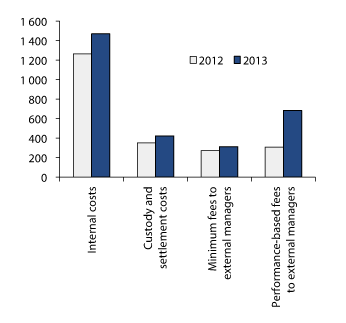
Figure 4.17 GPFG costs in 2012 and 2013, by cost components. NOK million
Source Norges Bank.
Operating and administration costs will be incurred in subsidiaries established in connection with the real estate investments. These costs are deducted, in line with the accounting provisions adopted by Norges Bank, from the return on the real estate portfolio, and are not charged to the asset management costs. These costs amounted to NOK 61 million in 2013, but are likely to increase somewhat in coming years as the real estate portfolio grows. These costs are included in the 9-basis point cost limit on reimbursements to Norges Bank from the Ministry.
International cost comparison
The company CEM Benchmarking Inc. has compared the costs of the Fund in 2012 with the costs of other funds, cf. report published on the Ministry website. The comparison shows that the GPFG has the cheapest asset management of all funds that submit data to CEM, when costs are measured relative to assets under management. One of the reasons is that the GPFG has few investments in asset classes that entail relatively high costs, like for example private equity and real estate. Another reason is that most of the assets are managed internally by Norges Bank and that the Bank makes only limited use of external managers. CEM also finds that internal management at Norges Bank is cost effective compared to the management activities of the other funds.
Cost developments over time
Asset management costs have increased over time in absolute terms, when performance-fees are excluded. Some costs depend on the size of the Fund and will increase when assets under management grow. Norges Bank has increased its asset management staff. Recent years have, in particular, seen a need for more man-years in connection with the real estate investments. This has, together with a general salary increase, resulted in higher internal costs. Costs have nonetheless increased at a slower pace than the value of the Fund, thus implying that costs as a percentage of assets under management have declined, cf. figure 4.18.
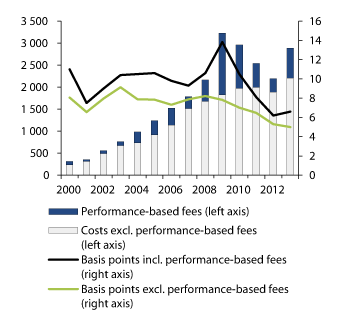
Figure 4.18 Developments in the GPFG asset management costs. Measured in NOK (left axis) and in basis points (right axis). One basis point = 0.01 percent
Source Norges Bank.
4.1.6 Environment-related mandates
In 2009, it was decided to establish specific mandates for environment-related investments within the GPFG, cf. Report No. 20 (2008–2009) to the Storting. The investments are made within the same limits as apply to the Fund’s other investments, and form part of the asset management performed by Norges Bank. In Report No. 15 (2010–2011) to the Storting, the Ministry wrote that it is intended for the investments to normally be in the range of NOK 20-30 billion.
High returns in 2013 contributed to the value of the investments being just in excess of NOK 31 billion at yearend 2013. At yearend, investments were held in 166 companies within renewable energy, water management and waste handling. The total return on the environment-related investments was about 41 percent in 2013, measured in the currency basket of the Fund. This is significantly better than the return on the other equity investments of the Fund. Nonetheless, these investments have underperformed the other equity investments of the Fund over time. The average annual return on the environment-related investments was 2.7 percent over the period 2010–2013, whilst the corresponding return on the equity portfolio of the Fund was 11.4 percent, cf. the discussion in section 2.2.3.
4.1.7 Operational reference portfolios
Norges Bank has established so-called operational reference portfolios for the equity and fixed income portfolios. Norges Bank measures its asset managers against these reference portfolios. The reference portfolios start out from the benchmark index defined by the Ministry, but modifications are made in order to, inter alia, better reflect the characteristics of the Fund. The deviations take place within the limits for deviations from the benchmark index. The reference portfolio for equities registered a return of 25.0 percent in 2013, which was on a par with the return on the benchmark index defined by the Ministry. The reference portfolio for bonds registered a return of -0.7 percent, which was 0.6 percentage points weaker than the return on the benchmark index. The difference was primarily caused by the reference portfolio for bonds featuring a larger portion of emerging market government bonds than the benchmark index.
4.1.8 Changes to the benchmark index for government bonds
The management of the fixed income portfolio of the GPFG is premised on a benchmark index developed by the index provider Barclays. The fixed income benchmark index of the GPFG is comprised exclusively of investment grade bonds, and is made up of two parts: 70 percent bonds issued by governments and 30 percent issued by companies.
In Report No. 17 (2011–2012) to the Storting, the Ministry described a number of changes to the strategic fixed income benchmark index of the GPFG. GDP weights were introduced for the government sub-index of the fixed income benchmark, together with a principle that the government sub-index shall include government bonds from all countries approved by Barclays (with the exception of Norwegian kroner). The Ministry stated, inter alia, the following:
“The Ministry also envisages the inclusion of all currencies forming part of the GDP Weighted Government Bond Index provided by Barclays Capital. If the index provider alters the selection of emerging market currencies included, the GPFG’s fixed income benchmark will be amended accordingly. As for the other parts of the government sub-index, the principle of GDP weighting of individual countries is to be used for the new emerging markets.”
Norges Bank has noted, in a letter of 14 March 2014 to the Ministry of Finance, that its overall experience with managing a GDP-weighted government bond portfolio is a positive one. The Bank states, at the same time, that this entails large ownership stakes for the Fund in countries with relatively high GDP and a small market for government bonds.
The Bank notes that the index provider Barclays announced, in November 2013, that nominal government bonds issued in Russian roubles and Turkish lira will be included in Barclays’ GDP-weighted index as from the close of trading on 31 March 20143, and that this change necessitates an assessment of the benchmark composition in view of reasonable requirements as to the investability of the Fund.
Norges Bank’s calculations show that the Fund, if it were to be invested in accordance with the benchmark index, would hold about 17, 14, 13 and 6 percent of the market for government bonds in Chile, Hong Kong, Russia and Turkey, respectively. The Bank states the following:
“We are of the view that this represents an excessive ownership stake in one single market, and that it would in practice be challenging to establish such an investment in a cost-effective manner. We are therefore of the view that the markets for government bonds in these countries are currently not investable for the Fund on the scale suggested by the benchmark index.”
The Bank further states that:
“The GDP weights of the strategic benchmark index for government bonds should be subject to an adjustment factor to ensure that the index is investable for the Fund. We recommend that the Ministry assigns a factor of 0.25 to Chile, Hong Kong and Russia and 0.5 to Turkey with effect from 31 March 2014”
The Ministry agrees with the assessment of the Bank that investability considerations suggest that the index weights of the stated four currencies should be adjusted. The adjustment factors have been specified in line with the proposal of the Bank. These changes have been implemented with effect from 1 April 2014. The Ministry has noted that the Bank intends to revert to the issue of investability in more general terms at a later date.
4.1.9 The Ministry’s assessment
2013 was a year of good performance. The return on the GPFG in 2013 of close to 16 percent was the second best performance since the Fund was established. 2013 was the second year in a row of high returns on the investments of the Fund. Returns were particularly high in the stock market, whilst yield increases brought fixed income portfolio returns close to zero. Both the equity and the fixed income portfolio outperformed the benchmark index. All in all, the GPFG investments outperformed the benchmark index by about 1.0 percentage point.
The Ministry is satisfied with the fact that the average annual return since 1998 has been 0.31 percentage points higher than that on the benchmark index. This performance is better than the expectation of ¼ percentage points previously expressed by the Ministry.
Unlisted real estate investment is a new asset class for Norges Bank. It is necessary to develop expertise and experience with this asset class, and that will take time. The Ministry is satisfied with how the Bank has discharged these duties thus far.
Norges Bank has established so-called operational reference portfolios that deviate from the benchmark indices defined in the mandate from the Ministry. The deviations take place within the limits for deviations from the benchmark index, as measured by tracking error. The Ministry deems it positive that the operational reference portfolios may contribute to the Fund exploiting its characteristics to improve the ratio between risk and return. The operational reference portfolios may also contribute to increased transparency in the operational implementation of the management of the Fund.
The Ministry is satisfied with the fact that asset management costs have been reduced in recent years, as a portion of assets under management. In comparison with other funds, the costs are low. This indicates that Norges Bank is able to exploit economies of scale in asset management. The Ministry is committed to keeping costs under control. The real estate investments will, when taken in isolation, increase costs, but growth in the size of the Fund should still offer a potential for exploiting economies of scale. The Ministry also acknowledges that changes in the Norwegian kroner exchange rate may influence the cost level.
4.2 Return measurement in international currency
4.2.1 Introduction
The objective of the investments in the GPFG is to maximise international purchasing power, given a moderate level of risk. Consequently, the main emphasis is on reporting the return on the GPFG in international currency, and not in Norwegian kroner, cf. box 4.1. This section discusses the method used to calculate the return on the Fund in international currency.
4.2.2 Current method for calculating the return on the GPFG
From a national perspective, the assets of the GPFG shall finance future purchases of goods and services produced internationally – i.e. future imports. The amount of foreign goods and services that can be financed by the Fund’s assets depends on the value of the Fund as measured in international currency, and not on its value as measured in Norwegian kroner.
No single currency is appropriate for reporting the return measured in international currency. A basket comprising several currencies is used instead. In the present currency basket, the currencies included in the benchmark index of the equity and fixed income investments of the Fund; currently 34 currencies, are weighted together.
Figure 4.19A illustrates that there can be significant differences from year to year between returns as measured in the currency basket and returns as measured in Norwegian kroner. This is because Norwegian kroner returns are influenced by fluctuations in the Norwegian kroner exchange rate. Over time, however, the effect of fluctuations in the Norwegian kroner exchange rate is less pronounced, see figure 4.19B.
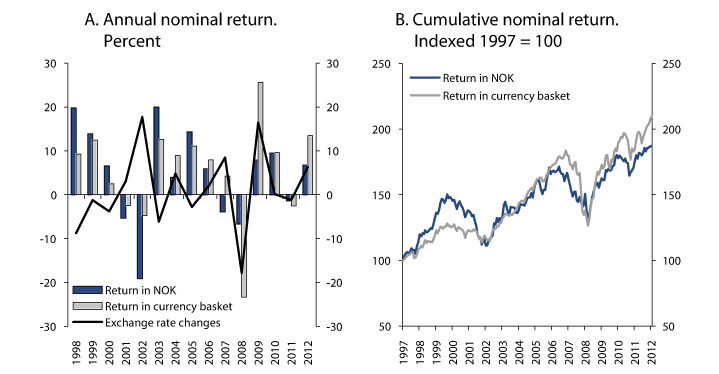
Figure 4.19 Nominal return on the GPFG, as measured in Norwegian kroner and in the currency basket of the Fund. 1998–2012
Source Norges Bank.
The nominal return on the Fund is calculated in compliance with the Global Investment Performance Standards (GIPS). Reference is made to the GIPS manual of Norges Bank, which is published, together with the annual reports of the GPFG, on the NBIM website (www.nbim.no/en).
At present, the real return on the Fund is calculated as a nominal return adjusted for weighted average international inflation (here referred to as the deflator of the Fund). The country weights of the deflator correspond to the weights in the currency basket of the Fund. Inflation in each country is measured by changes in the consumer price index of the country in question. An increase in consumer prices is a well-established measure of general price growth (inflation). In other words, the current calculation method for the real return on the GPFG expresses the overall return on the Fund adjusted for inflation in the markets and currencies in which the Fund is invested. This is used as an approximate measure of developments in the international purchasing power of the Fund.
4.2.3 Choice of currency basket
The present method of calculation, using a currency of measurement with the same currency distribution as the equity and fixed income benchmark of the Fund, may be termed an investment approach, since the currency of measurement is closely aligned with the actual investments. Hence, currency volatility has low impact on measured returns.
An alternative approach would be to measure the return on the basis of what such return is going to be spent on. This may be termed a consumption approach. Unlike the investment approach, the relevant weights under a consumption approach are not known. The composition of future imports will depend, inter alia, on economic developments in both Norway and internationally, on preferences and on technological developments.
Figure 4.20 shows the return as measured by two alternative currency baskets based on consumption approaches, in addition to the present currency basket and Norwegian kroner. The weights of the currency basket designated as I44 are based on the statistics compiled by Statistics Norway on Norwegian imports from the 44 largest countries, as measured by import value. The weights of the currency basket designated as GDP18 are based on the countries that contribute more than one percent to world GDP. Calculations based on GDP weights may be considered an approximation of developments in international purchasing power if one assumes that future import patterns are correlated with the distribution of global production of goods and services.
The figure shows that returns as measured in Norwegian kroner differ significantly from returns in international currency. However, differences between the various currency baskets are relatively minor, with the exception of the years 2002 and 2003. The small return differences reflect, inter alia, the fact that the four major currencies US dollars, euro, pound sterling and Japanese yen dominate all of the selected baskets.
4.2.4 Choice of deflator
Developments in the international purchasing power of the Fund are best captured by measuring the performance of the Fund in a suitable currency basket. Thereafter, nominal returns are adjusted for a suitable measure of international inflation; a deflator. Calculating the deflator requires a choice between different indices for developments in the prices of goods and services (price indices). In addition, it is necessary to choose a method for weighting together inflation data from different countries (weights). The Ministry has requested, against this background, Statistics Norway to calculate historical developments for the following alternative deflators:
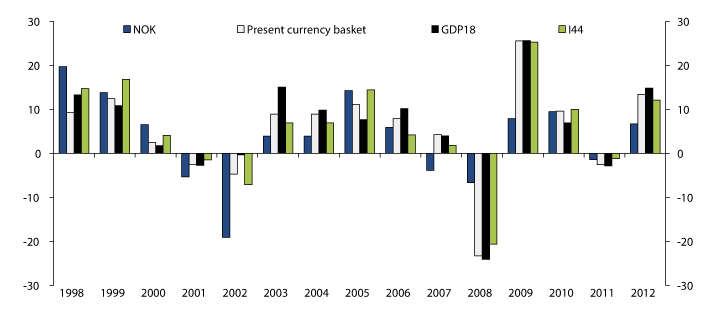
Figure 4.20 Nominal return on the GPFG, 1998–2012, as measured in Norwegian kroner and in different currency baskets. Percent
Source Statistics Norway, Norges Bank and the Ministry of Finance.
Import weights and CPI presents a weighted average of international consumer price indices, with the weights being determined by the import weights of the various countries from the perspective of the Norwegian economy. Import weights are an appropriate alternative for the choice of country weights. In order to limit data requirements, Statistics Norway is focusing on Norway’s 20 main trading partners only. Consumer price indices measure developments in the prices of goods and services consumed in the home country. The advantage of this measure of price developments is availability and frequent updating (monthly in most countries). A disadvantage is that the goods and services included in consumer price indices are not necessarily in conformity with actual Norwegian imports.
Import weights and export prices are based on international export prices, again weighted by Norway’s import weights for 20 countries. International export prices may provide a better indication of developments in the purchasing power of the GPFG, given that these reflect the prices that Norwegian importers are faced with in the global market for goods and services.
Import weights and CPI with “China effect” and Import weights and export prices with “China effect” are alternatives based on the deflators described above, but adjusted for a so-called “China effect”. The adjustment factor is intended to capture the redistribution of Norwegian imports away from countries with high price levels and low inflation towards low-cost countries that often have higher inflation. This price-reducing effect is not captured by traditional methods for calculating price indices. The method employed is still being developed by Statistics Norway, and hence the magnitude of the said effect is uncertain.
GDP and CPI uses consumer price indices weighted by the distribution of world GDP. Norway’s future import pattern is subject to considerable uncertainty. The motivation behind this alternative is that current import weights do not necessarily provide the best illustration of the future composition of Norway’s trading partners. The distribution of global production may be a better alternative.
GDP and GDP deflator uses international GDP deflators weighted by countries’ relative shares of total GDP. A GDP deflator is a recognised measure of inflation in a country’s production of goods and services. The GDP deflator is, at the same time, the deflator with the broadest composition of goods and services and includes, inter alia, public services and investments. Discrepancies in the composition of goods between a deflator and Norway’s import pattern represent, to an even greater extent than for CPI, a disadvantage of the GDP deflator.
Statistics Norway has compared these alternative deflators with Norges Bank’s reported international inflation4 and Statistics Norway’s import deflator from the national accounts.
Table 4.5 summarizes the main findings from Statistics Norway’s report. The report is published on the Ministry website (www.regjeringen.no/gpf). For the current method, Import weights and CPI and Import weights and CPI with China effect, the calculation of nominal return and deflator are presented in both Norwegian kroner and the relevant currency basket.
Table 4.5 shows that the measured real return is the same irrespective of whether the calculation is made in Norwegian kroner or in the currency basket of the Fund (I36). Hence, the choice of the currency of measurement is not relevant, provided that the nominal return and the deflator are calculated consistently.
Table 4.5 Alternative calculations of the real return on the GPFG over the period 1998–2012.
Deflator | Set of weights | Set of prices | Currency | Nominal return (percent) | Annual inflation (percent) | Real return (percent) | Deviation (percentage points) |
|---|---|---|---|---|---|---|---|
Return based on GIPS*: | |||||||
Current method | GPFG | CPI | I36 NOK | 5.1 4.3 | 1.9 1.2 | 3.1 3.1 | 0.0 0.0 |
Import weights and CPI | I20 | CPI | I20 NOK | 5.0 4.3 | 2.2 1.4 | 2.8 2.8 | -0.3 -0.3 |
Import weights and CPI with “China effect” | I20 | CPI | I20 NOK | 5.0 4.3 | 0.9 0.2 | 4.1 4.1 | 1.0 1.0 |
Growth rate based on changes in annual average levels**: | |||||||
Import weights and export prices | I20 | export prices | 3.3 | 0.7*** | |||
Import weights and export prices with “China effect” | I20 | export prices | 4.5 | 1.8*** | |||
GDP and CPI | GDP18 | CPI | 2.3 | -0.3*** | |||
GDP and GDP deflator | GDP18 | GDP deflator | 2.4 | -0.2*** | |||
Import deflator | I44 | import prices | 2.3 | -0.4*** | |||
* Return is calculated as the value of the return index as at the end of year t, divided by the value of the return index as at the beginning of year t, minus 1.
** Growth rates are calculated as the average level of the return index in year t+1, divided by the average level of the return index in year t, minus 1.
*** The relevant basis for comparison of the values is 2.6, since the growth rate is based on changes in annual average levels, cf. the report from Statistics Norway.
Source Statistics Norway and the Ministry of Finance.
Moreover, table 4.5 shows that Statistics Norway has used two different real return definitions in its report, since it was not possible to calculate returns in accordance with the internationally recognised GIPS for the deflators based on national account figures (GDP deflator, export prices and import prices). For these deflators, the annual “return” was calculated from the difference in average levels between the current year and the previous year, corrected for inflow. By using this method, Statistics Norway was able to calculate the effect of several alternative sets of weights and prices.
Three main effects are evident from the calculations of Statistics Norway, when compared to the actually reported figures:
GDP weights or import weights will, all else being equal, result in a lower measured real return over the period, because countries with higher inflation over the period are accorded more weight.
International export prices will result in a higher measured real return because the prices of tradable goods have increased by less than CPI.
If the so-called China effect is included in the calculations, the real return is increased further, because measured inflation is reduced. It should be noted that the method for calculating the China effect is subject to some uncertainty.
Table 4.5 shows that measured real return until 2012 is in the 2.3–4.5 percent range. Real return as measured by the current method is roughly in the middle of this range. Furthermore, the alternative using a GDP deflator results in more or less the same outcome as using CPI.
Use of the import deflator from the national accounts produces a measured real return that is one percentage point lower than the deflator based on import weights and export prices. Generally speaking, one would expect the import deflator to generate an outcome between the alternatives Import weights and export prices and Import weights and export prices with China effect, since the import deflator is based on the prices of tradable goods and hence should capture changes in the composition of trade flows. Statistics Norway indicates that the unexpected outcome may be caused by problems with the data used to calculate the import deflator.
4.2.5 The Ministry’s assessments
The calculations of alternative deflators and currency baskets illustrate that any real return calculation is subject to uncertainty and is sensitive to the assumptions made.
The Ministry is of the view that the currency basket and deflator analyses lend credence to the current method for reporting the return on the GPFG in international currency. The present calculation method is based on an investment approach, in the sense that one uses the currency and country composition from the benchmark index of the Fund in the calculation of nominal returns and international inflation.
Nonetheless, the current calculation method is only an approximation of a fully adequate measure for the international purchasing power of the Fund. Ideally speaking, purchasing power should be measured on the basis of what one is going to purchase. Future consumption is, at the same time, subject to considerable uncertainty. Future import will depend on economic developments in both Norway and internationally, on individual preferences, on technological developments, as well as on a number of other factors.
It is difficult to conclude, based on the analyses commissioned by the Ministry, that alternative baskets and deflators provide a significantly better illustration of developments in the international purchasing power of the Fund than the present calculation method. The challenge lies in the fact that it is difficult to measure future purchasing power with any precision. This problem is not resolved by any of the alternative methods presented in this report.
GDP deflator, export prices and import prices are all sets of prices based on national account figures. One practical implication of this is that inflation can only be calculated as the difference between average price levels in two subsequent years. This limitation suggests that it will not be possible to calculate a deflator based on such sets of prices that is, at the same time, consistent with nominal return figures calculated in compliance with the international standard for the reporting of return figures; GIPS.
The Ministry is of the view that major uncertainty with regard to future consumption, limited data availability for alternative sets of prices, as well as the observation that the current method would appear to neither overestimate, nor underestimate, developments in the international purchasing power of the Fund, suggest that the current method of real return reporting should be retained.
4.3 Performance of the Government Pension Fund Norway
4.3.1 Market developments in 2013
Stock markets in Norway and the rest of the Nordic region experienced strong growth in 2013. The main index of the Oslo Stock Exchange gained 24 percent over the year, and reached an all time-high on 27 December. The strong equity price performance had to do with increased risk appetite amongst investors and positive underlying developments in the world economy. Other Nordic stock markets also registered strong performance in 2013. Swedish, Danish and Finnish equities delivered returns of 26 percent (OMXSB index), 27 percent (OMXCB index) and 35 percent (OMXHB index), respectively.
At yearend 2013, the yield on Norwegian government bonds with a long time to maturity was significantly higher than at the beginning of the year. Whilst the average yield on 10-year Norwegian government bonds was 2.0 percent at yearend 2012, the corresponding yield was 3.0 percent at yearend 2013. The yield on Norwegian treasury bills declined slightly from January to December 2013. The yield spread between loans to banks and loans to corporates also declined somewhat over the year. The fixed income markets in Sweden, Denmark and Finland developed correspondingly.
4.3.2 The market value of the Fund
At yearend 2013, the market value of the GPFN was NOK 168 billion; NOK 23 billion higher than at the beginning of the year, cf. figure 4.21. The value of the equity portfolio was just over NOK 105 billion, of which about NOK 88 billion comprised Norwegian equities and close to NOK 17 billion comprised equities in the other Nordic countries. The value of the fixed income portfolio was NOK 63 billion at yearend, comprised of NOK 53 billion in bonds from Norwegian issuers and NOK 10 billion in bonds from issuers in the other Nordic countries. The distribution of fund assets at yearend 2013 is presented in figure 4.22.
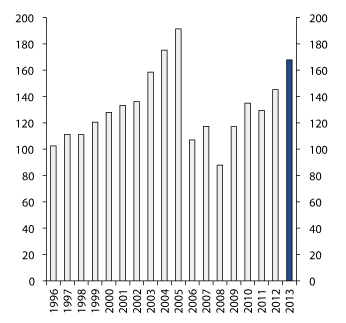
Figure 4.21 Developments in the market value of the GPFN, 1996–2013. NOK billion1
1 A major part of the GPFN assets was invested with the Treasury in the form of mandatory deposits until 2005. The mandatory deposits were discontinued in December 2006. This implied that the State redeemed deposits valued at NOK 101.8 billion, and that a corresponding amount was repaid to the State from fund assets.
Source Folketrygdfondet.
The GPFN is a major investor in the Norwegian stock market. At yearend 2013, the value of the Norwegian equity portfolio of the Fund represented about 5 percent of the value of all equities on the Oslo Stock Exchange. Moreover, the Norwegian equity portfolio of the GPFN represented about 10 percent of the value of the equities included in the main index (OSEBX) of the Oslo Stock Exchange, which is the benchmark index of the Fund for Norwegian equities. The GPFN is a smaller investor, in relative terms, in the rest of the Nordic region. The Nordic equity portfolio of the Fund accounted for about 0.3 percent of the value of the equities included in the Nordic equity index VINX at yearend 2013, excluding Norway and Iceland.
4.3.3 Return
The overall portfolio
The GPFN registered an aggregate return of 15.7 percent in 2013, measured in Norwegian kroner and before the deduction of asset management costs, cf. table 4.6. The strong performance was primarily the result of high stock market returns. Declining yields reduced bond market returns.
The return on the Fund is compared to a benchmark defined by the Ministry. All in all, Folketrygdfondet underperformed the benchmark index by 0.9 percentage points, before the deduction of asset management costs, in 2013.
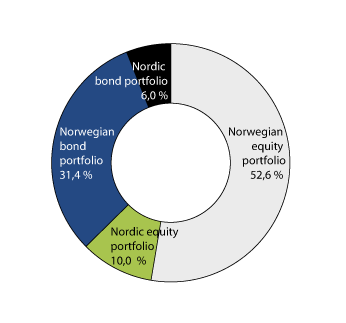
Figure 4.22 Distribution of the GPFN across asset classes at yearend 2013. Percent
Source Folketrygdfondet.
Equities
The equity portfolio achieved a return of 24.2 percent in 2013. The Norwegian companies in the equity portfolio delivered a return of 21.6 percent, whilst the Nordic companies in the equity portfolio returned 39.7 percent, measured in Norwegian kroner. Norwegian kroner depreciated by about 10 percent against Swedish kronor and 14 percent against euros and Danish kroner. When taken in isolation, this increased the return on the Nordic companies in the equity portfolio, as measured in Norwegian kroner. The Norwegian and other Nordic stock markets largely tracked international stock markets in 2013, appreciating over the year in response to improvements in the world economy and continued expansive monetary policy internationally.
The equity portfolio underperformed the benchmark index by 2.1 percentage points. The Norwegian companies in the equity portfolio underperformed the benchmark index by 2.0 percentage points, whilst the investments in other Nordic companies underperformed the benchmark index by 2.6 percentage points.
The manufacturing industry and energy sectors contributed the most to the negative excess return, whilst consumer goods and the financial sector made positive excess return contributions. Folketrygdfondet emphasises the long-term risk and return characteristics of companies. The predictability and quality of expected company cash flows is one of several criteria determining the investments made by Folketrygdfondet. Folketrygdfondet will typically not choose to invest in companies characterised by high financial and/or operational risk, or to underweight such companies relative to the benchmark index. This strategy had a negative impact in 2013. Several companies characterised by high financial and/or operational risk registered the strongest stock market performance in 2013 due to, inter alia, a reduced risk premium in the stock market.
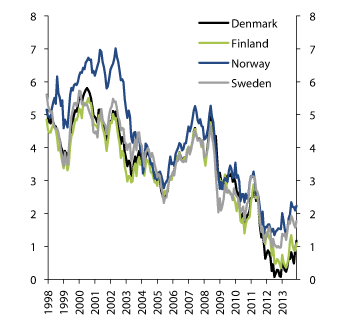
Figure 4.23 Yields on 5-year government bonds from the Nordic countries, 1998–2013. Percent
Source Macrobond.
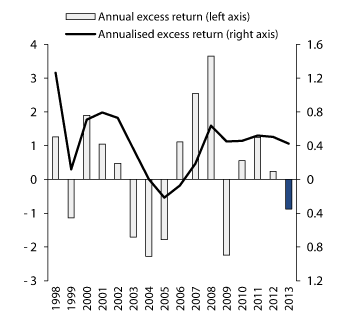
Figure 4.24 Gross excess return performance of the GPFN, 1998–2013. Percentage points
Source Folketrygdfondet and the Ministry of Finance.
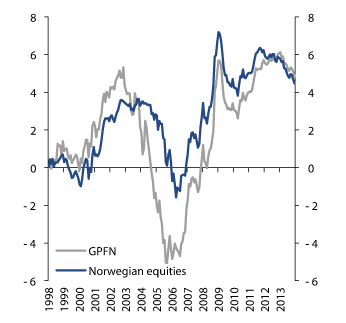
Figure 4.25 Accumulated excess return on the GPFN 1998–2013. NOK billion
Source Folketrygdfondet and the Ministry of Finance.
Bonds
The fixed income portfolio achieved a return of 3.1 percent in 2013. The return on the Norwegian part of the fixed income portfolio was 1.6 percent, whilst the Nordic part delivered a return of 12.2 percent measured in Norwegian kroner. This high return on the Nordic bonds was caused by the depreciation of Norwegian kroner against Swedish kronor, Danish kroner and euros.
Both Norway and the other Nordic countries experienced rising yields on government bonds with a long time to maturity, which reduced returns. The yield level remains somewhat higher in Norway than in the other Nordic countries, thus resulting in somewhat higher current returns on Norwegian government bonds. At yearend, the yield on Norwegian government bonds with five years to maturity was about 2.2 percent. The yield on Swedish, Danish and Finnish government bonds with same time to maturity was 1.8 percent, 1.2 percent and 1.1 percent, respectively, cf. figure 4.23. The low yield level limits the scope for high returns on the fixed income portfolio in coming years.
Businesses normally need to offer higher yields than governments in order to borrow money. This means that corporate bonds often offer somewhat higher returns than government bonds. In 2013, the premium that businesses need to pay on top of government bond yields declined, which served to further increase corporate bond returns.
The fixed income portfolio outperformed the benchmark index by 0.8 percentage points. The excess return was 0.9 percentage points for the Norwegian part of the portfolio and 0.5 percentage points for the Nordic part. The main reason for the excess return was the current yield of the Fund being higher than that of the benchmark index throughout 2013. The high current yield reflected both a higher portion of corporate bonds and a somewhat lower average credit rating for the actual portfolio than for the benchmark index.
Performance measured over time
From January 1998 to December 2013, the GPFN has registered an average annual return of 7.1 percent. This is 0.4 percentage points higher than the return on the benchmark index, cf. figure 4.24. The Ministry has previously expressed an expectation for an annual net value added from the active management of the GPFN of ¼ – ½ percentage points, cf. Report No. 15 (2010–2011) to the Storting – The Management of the Government Pension Fund in 2010. Over the said period, the excess return on the Norwegian equity portfolio was 1.4 percentage points, whilst the excess return on the Norwegian fixed income portfolio was 0.2 percentage points. The GPFN was not invested in Nordic equities and bonds in 1998. If one studies a shorter period, the Nordic portfolios have generally registered somewhat lower excess returns than the corresponding Norwegian portfolios, cf. table 4.6. The Ministry has estimated that the gross excess return on the Fund over the period 1998–2013 amounts to a total of about NOK 5 billion5, cf. figure 4.25.
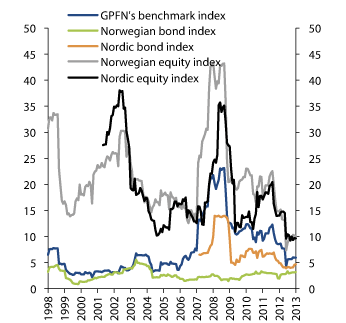
Figure 4.26 Developments in the 12-month rolling standard deviation of the GPFN benchmark indices. Percentage points
Source Folketrygdfondet and the Ministry of Finance.
Table 4.6 Return on the GPFN in 2013, the last 3, 5 and 10 years, as well as over the period 1998–2013, measured in Norwegian kroner. Annual geometric average. Percent
Last year | Last 3 years | Last 5 years | Last 10 years | 1998–2013 | |
|---|---|---|---|---|---|
GPFN | |||||
Actual portfolio | 15.71 | 7.63 | 13.92 | 7.77 | 7.13 |
Benchmark index | 16.58 | 7.35 | 14.01 | 7.31 | 6.70 |
Excess return | -0.87 | 0.28 | -0.09 | 0.46 | 0.43 |
Equities (Norway and the Nordic region in total) | |||||
Actual portfolio | 24.22 | 7.96 | 18.16 | 12.30 | 7.91 |
Benchmark index | 26.31 | 8.20 | 19.07 | 12.04 | 6.60 |
Excess return | -2.09 | -0.24 | -0.91 | 0.26 | 1.31 |
Norwegian equities | |||||
Actual portfolio | 21.59 | 7.52 | 18.67 | 12.72 | 8.25 |
Benchmark index | 23.59 | 7.67 | 19.47 | 12.37 | 6.90 |
Excess return | -2.00 | -0.15 | -0.80 | 0.35 | 1.36 |
Nordic equities1 | |||||
Actual portfolio | 39.67 | 10.06 | 14.99 | 9.90 | |
Benchmark index | 42.27 | 10.92 | 16.58 | 9.70 | |
Excess return | -2.60 | -0.86 | -1.59 | 0.20 | |
Bonds (Norway and the Nordic region in total) | |||||
Actual portfolio | 3.13 | 6.32 | 6.72 | 5.60 | 6.03 |
Benchmark index | 2.36 | 5.16 | 5.46 | 5.20 | 5.83 |
Excess return | 0.77 | 1.16 | 1.26 | 0.40 | 0.20 |
Norwegian bonds | |||||
Actual portfolio | 1.60 | 6.12 | 7.23 | 5.66 | 6.11 |
Benchmark index | 0.73 | 4.86 | 5.91 | 5.20 | 5.87 |
Excess return | 0.86 | 1.26 | 1.32 | 0.46 | 0.24 |
Nordic bonds2 | |||||
Actual portfolio | 12.22 | 7.43 | 3.78 | ||
Benchmark index | 11.70 | 6.79 | 2.81 | ||
Excess return | 0.52 | 0.64 | 0.97 | ||
Real return | |||||
Inflation | 2.13 | 1.38 | 1.74 | 1.75 | 2.00 |
Costs | 0.10 | 0.09 | 0.09 | 0.06 | 0.05 |
Net real return | 13.20 | 6.08 | 11.89 | 5.85 | 4.98 |
1 Nordic equity investments commenced in May 2001.
2 Nordic fixed income investments commenced in February 2007.
Source Folketrygdfondet and the Ministry of Finance.
4.3.4 Risk and limits
Fund risk
Expected standard deviation is a measure of expected normal variations in the return on the Fund. Folketrygdfondet has estimated that the expected standard deviation was 12.1 percentage points as at yearend 2013, or about NOK 20 billion with a fund size of NOK 168 billion. Fluctuations will exceed the said amount in one out of three years if we assume, for the sake of simplicity, a normal distribution over time.
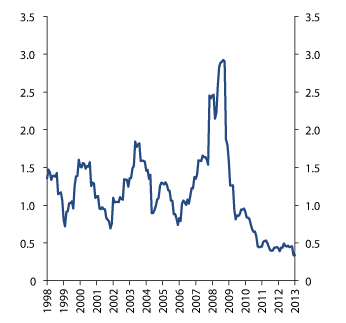
Figure 4.27 Rolling 12-month realised tracking error of the GPFN, 1998–2013. Percentage points
Source Folketrygdfondet and the Ministry of Finance.
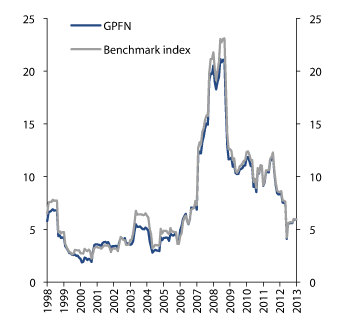
Figure 4.28 Rolling 12-month standard deviation of the actual portfolio of the GPFN vs. the benchmark index, 1998–2013. Percentage points
Source Folketrygdfondet and the Ministry of Finance.
Figure 4.26 shows how the realised standard deviation of the GPFN has developed since 1998. The standard deviation is calculated on the basis of returns over the preceding 12 months. Based on these calculations, risk declined in the first half of 2013, but then increased somewhat again in the second half of the year. At yearend, the measured risk of the Fund as a whole was somewhat lower than its risk at the beginning of the year. Risk in the equity portfolio in 2013 was low compared to historical developments, whilst risk in the fixed income portfolio was at a more normal level. The overall risk in the Fund is primarily affected by developments in the equity portfolio.
Relative risk
The mandate for the GPFN requires Folketrygdfondet to organise its management activities with a view to ensuring that expected tracking error does not exceed 3 percentage points. Expected tracking error is a statistical measure showing by how much annual excess returns can be expected to fluctuate. According to Folketrygdfondet, expected tracking error was in the range of 0.5 – 0.8 percentage points in 2013. At yearend, expected tracking error was 0.8 percentage points, somewhat higher than at the beginning of the year. Nonetheless, Folketrygdfondet is only utilising a minor part of the 3-percentage point limit.
Realised tracking error expresses the magnitude of the actual fluctuations in achieved excess return. Realised tracking error was about 0.3 percentage points over the last 12 months, cf. figure 4.27 and table 4.7. Realised tracking error over the last 12 months may seem low given the negative excess return on the Fund. The explanation lies in several months of low negative excess returns, thus implying that the fluctuations in negative excess returns were generally low. Both expected and realised tracking error were at historically low levels at yearend 2013, and considerably below the limit stipulated in the mandate. The measurement of tracking error is affected by fluctuations in the overall market. In 2013, market fluctuations were small, which contributed to a low calculated tracking error. Tracking error must be expected to increase during periods of larger market fluctuations.
Table 4.7 Absolute and relative risk measures for the GPFN. Annual data based on monthly observations
Last year | Last 3 years | Last 5 years | Last 10 years | 1998–2013 | |
|---|---|---|---|---|---|
GPFN | |||||
Absolute volatility (percentage points) | 5.94 | 8.05 | 9.81 | 10.43 | 8.60 |
Tracking error (percentage points) | 0.34 | 0.47 | 0.90 | 1.35 | 1.31 |
Skewness | -1.19 | -0.63 | -0.01 | -1.13 | -1.22 |
Kurtosis | 5.63 | 3.69 | 3.11 | 6.75 | 8.98 |
Information ratio | -2.53 | 0.60 | -0.10 | 0.34 | 0.33 |
Norwegian equities | |||||
Absolute volatility (percentage points) | 10.13 | 14.46 | 17.52 | 20.94 | 21.75 |
Tracking error (percentage points) | 0.62 | 0.86 | 1.67 | 3.08 | 3.90 |
Skewness | -0.58 | -0.37 | 0.05 | -1.16 | -0.95 |
Kurtosis | 4.49 | 3.88 | 3.02 | 6.03 | 5.12 |
Information ratio | -3.23 | -0.18 | -0.48 | 0.11 | 0.35 |
Nordic equities | |||||
Absolute volatility (percentage points) | 9.68 | 15.03 | 17.07 | 17.11 | |
Tracking error (percentage points) | 0.74 | 0.78 | 1.23 | 1.43 | |
Skewness | -0.28 | -0.98 | -0.02 | -0.32 | |
Kurtosis | 2.28 | 4.23 | 5.58 | 4.42 | |
Information ratio | -3.53 | -1.10 | -1.30 | 0.14 | |
Norwegian bonds | |||||
Absolute volatility (percentage points) | 2.88 | 2.50 | 2.49 | 2.45 | 2.52 |
Tracking error (percentage points) | 0.40 | 0.74 | 0.75 | 1.00 | 0.87 |
Skewness | -0.32 | -0.43 | -0.39 | 0.19 | 0.24 |
Kurtosis | 1.33 | 2.61 | 2.54 | 3.07 | 3.43 |
Information ratio | 2.16 | 1.72 | 1.78 | 0.46 | 0.28 |
Nordic bonds | |||||
Absolute volatility (percentage points) | 4.69 | 5.13 | 6.73 | ||
Tracking error (percentage points) | 0.15 | 0.32 | 0.62 | ||
Skewness | 0.08 | -0.05 | -1.40 | ||
Kurtosis | 1.34 | 2.36 | 8.46 | ||
Information ratio | 3.49 | 2.01 | 1.56 |
Source Folketrygdfondet and the Ministry of Finance.
Figure 4.28 shows developments in the standard deviations of both the GPFN benchmark index and the actual fund portfolio. The standard deviation of the actual portfolio has been less than that of the benchmark index for major parts of the period. This has been especially pronounced in sub-periods of increasing market volatility. The figure shows that overall risk in the Fund is predominantly determined by the benchmark index, although management by Folketrygdfondet may in some periods have reduced the overall risk somewhat.
The equity portion of the Fund was increased from less than 20 percent to 60 percent over the period from 2006 to 2008. This change heralded a general increase in the standard deviation, and is the main reason why standard deviation appears to be at a higher level after 2007 than before.
Credit risk
Folketrygdfondet has somewhat increased the average credit rating of the fixed income portfolio during 2013, principally by increasing the portion of loans with a high credit rating (AAA6 and AA), as well as reducing the portion with a moderate credit rating (A and BBB). Bonds with a low credit rating, so-called high-yield bonds, are not included in the GPFN benchmark index. The mandate for the Fund nonetheless allows Folketrygdfondet to invest in such securities within a defined limit. Folketrygdfondet is required to organise its asset management with a view to ensuring that such bonds do not represent more than 25 percent of the market value of corporate bonds in the fixed income portfolio under normal market conditions. At yearend 2013, high-yield bonds represented just over 13 percent of the corporate bonds in the fixed income portfolio, or about 10 percent of the overall fixed income portfolio. This is about the same level as at the beginning of the year.
Individual investments
The GPFN is a major investor in the Norwegian stock market. At yearend 2013, the Fund held ownership stakes of more than 10 percent in three companies, and more than 5 percent in 30 companies, cf. table 4.8. The GPFN is a much smaller investor in the Nordic market, with an ownership stake of more than 1 percent in only one of the 106 companies in which the Fund was invested.
Table 4.8 GPFN ownership stakes in Norwegian companies in 2013
Number of companies where the ownership stake exceeds | Norwegian companies | Nordic companies |
|---|---|---|
10 percent | 3 | 0 |
5 percent | 30 | 0 |
1 percent | 48 | 1 |
0.5 percent | 49 | 11 |
0.1 percent | 50 | 77 |
Total number of companies invested in the GPFN | 51 | 106 |
Source Source: Folketrygdfondet.
The Fund is a financial investor. The Fund aims to diversify risk across many different securities. The Ministry has therefore stipulated that it shall hold no more than 15 percent of the stocks of any one Norwegian company and no more than 5 percent of the stocks of any companies from other Nordic countries. At yearend 2013, the largest ownership stake in a Norwegian company was 11.0 percent. The largest single ownership stake in the Nordic equity portfolio was 1.1 percent.
Overlap
Overlap shows what portion of the actual portfolio is identical to the benchmark index. If overlap is 100 percent, the actual portfolio comprises the same companies as are included in the benchmark index and each company accounts for the same portion of the actual portfolio as of the benchmark index. If the actual portfolio is invested in equities of companies that are not included in the benchmark index, or if Folketrygdfondet chooses to be overweighted in some companies and underweighted in others, overlap is reduced. Overlap between the Norwegian equity portfolio and the benchmark index has increased in recent years. Overlap was just above 90 percent from late 2011 until the end of 2013, cf. figure 4.29. Developments in recent years suggest that the portfolio matches the benchmark index more closely than before. This is mirrored by a reduction in tracking error over the same period. Variations in overlap with the benchmark index have been greater for the Nordic equity portfolio. At yearend 2013, overlap was about 91 percent in the Norwegian part and 85 percent in the Nordic part of the equity portfolio.
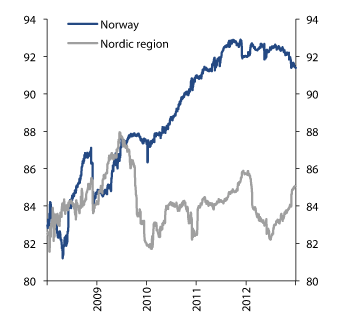
Figure 4.29 Overlap between the actual equity portfolios of the GPFN and its benchmark indices, 2009–2013. Percent
Source Folketrygdfondet.
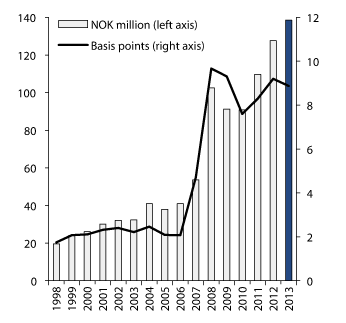
Figure 4.30 Developments in GPFN asset management costs, 1998–2013. Measured in NOK million (left axis) and in basis points (right axis)
Source Folketrygdfondet.
4.3.5 Costs
According to the mandate from the Ministry, the actual asset management costs of Folketrygdfondet are covered up to a fixed Norwegian kroner limit. The Norwegian kroner limit is determined on the basis of a reasoned proposal from Folketrygdfondet, in which aggregate costs are the sum total of a number of individual components. The Ministry defines an overall cost limit, and does not take a view on each individual cost component.
The overall asset management fee limit for 2013 was NOK 160 million, including investments. This amount was intended to cover the costs of Folketrygdfondet in relation to both the GPFN and the Government Bond Fund (GBF), as well as dividends for the State. Total asset management costs in 2013 were NOK 145 million, inclusive of dividends. In addition, investments were made in the amount of NOK 7 million. Consequently, total expenses were NOK 152 million, which was about NOK 8 million below the limit.
NOK 139 million of the total asset management costs in 2013 pertained to the GPFN, with the residual amount of NOK 6 million being costs relating to the GBF. Measured as a portion of assets under management, GPFN costs represented 8.9 basis points (0.089 percent).
Figure 4.30 shows the development in asset management costs over time. Costs have increased since 2006. This has to do with much stricter management and compliance requirements with regard to risk and reporting, which have entailed major systems investments and additional man-labour years.
The company CEM Benchmarking Inc. compares the costs of the GPFN with the costs of other funds. The most recent report examines costs in 2012 and shows that costs as a percentage of GPFN assets under management are significantly lower than the average costs of other funds. The GPFN is not invested in asset classes like private equity and real estate, which generally involve high costs. However, CEM finds that the costs of the GPFN are low even if adjusting for asset composition differences. The main reason for this is that all management of the GPFN is handled internally by Folketrygdfondet.
4.3.6 The Ministry’s assessment of GPFN performance
2013 was a year of high stock market returns, whilst returns in the fixed income markets were generally low due to increasing yield levels. Norwegian kroner depreciated against the currencies of the other Nordic countries, which resulted in high returns on investments in those countries. Overall, Folketrygdfondet underperformed the benchmark index by about 0.9 percentage points in 2013. The Ministry has noted that the negative excess return on the Fund was caused by weak equity management performance, whilst fixed income management generated a positive excess return. The Ministry is primarily concerned about performance over time and is satisfied with the fact that the annual average excess return since 1998 has been about 0.4 percentage points.
The Ministry has noted that Folketrygdfondet’s deviations from the benchmark index, as measured by expected tracking error, are moderate when compared to the limit stipulated in the mandate. It is, at the same time, anticipated that expected tracking error will increase somewhat if market risk increases.
The costs of Folketrygdfondet have increased considerably in recent years, which has to do with much stricter risk management and compliance requirements. Despite this increase, costs as a percentage of assets under management are low compared to those of other funds. The Ministry finds it satisfactory that the management of the GPFN appears to be cost effective under the new management framework.
4.4 Follow-up of the management framework
4.4.1 Norges Bank’s risk management and compliance framework for active management
The Supervisory Council of Norges Bank has commissioned the external auditor of the Bank (Deloitte) to perform an assurance engagement reviewing Norges Bank’s risk management and compliance framework for active management of the GPFG. The purpose of such review was to assess the risk management and compliance processes established to support active management. The auditor has examined the following elements of the risk management and compliance framework for active management: delegation of investment mandate, governance structure, information flow (compliance, monitoring and reporting), as well as periodical review.
The auditor has examined neither the real estate asset class or responsible investment processes, nor whether objectives defined or risks identified by the Bank are complete and representative of the Bank’s activities. Besides, the auditor has not examined whether the investment strategies are appropriate or whether active management performance is satisfactory.
The auditor’s review did not uncover any material deviations from the measurement criteria established for such review. Deloitte notes that the assessment was based on the current risk profile. It is emphasised that potential changes to the securities composition in the form of, for example, increased derivatives exposure, or increased utilisation of the tracking error limit, may make matters that are currently immaterial become more important, and thus merit reassessment in the context of a different risk profile. The assurance report is published on Norges Bank’s website.7
4.4.2 Independent review of the return data
The Ministry of Finance has commissioned the Spaulding Group to review the GPFG return data. The Spaulding Group is also Norges Bank’s independent GIPS (Global Investment Performance Standards) compliance reviewer; see report published on the Bank website (www.nbim.no/en).
The Spaulding Group receives, at the request of the Ministry, data on holdings directly from Norges Bank’s custodian for those asset classes where such information is available, i.e. for listed equities and bonds. Based on these data, the consultancy firm calculates returns, measured in Norwegian kroner, for the asset classes equities and bonds. The Spaulding Group also verifies, based on supplementary data on the GPFG benchmark indices from the Ministry of Finance, return data measured in the currency basket of the Fund.
The verification calculations made by the Spaulding Group for the financial year 2013 show no deviations from the return data reported by Norges Bank. The report of the consultancy firm is published on the Ministry’s website (www.government.no/gpf).
4.4.3 International frameworks
OECD Guidelines for Multinational Enterprises
Norges Bank shall exercise the Fund’s ownership rights on the basis of recognised international standards and principles, such as the UN Global Compact, the OECD Principles of Corporate Governance and the OECD Guidelines for Multinational Enterprises, cf. the discussion in section 4.5.
The OECD Guidelines for Multinational Enterprises express voluntary and non-legal recommendations on how multinational enterprises are expected to exercise responsible business conduct. What enterprises the guidelines may be applicable for is not specifically defined, since the guidelines have the status of recommendations. In principle, it is up to each enterprise to assess whether and how the guidelines is applicable to exercise responsible business conduct. Consequently, the guidelines do not require compliance in the legal sense, and hence one does not use terms like “violations” to characterise perceived non-observance of the recommendations. There is, nonetheless, an expectation that enterprises will observe the guidelines to the extent applicable to each enterprise.
The states that have signed up to the guidelines have committed to promote and implement the guidelines. Each country shall also establish a national contact point charged with promoting the application of the guidelines and assisting with guidance and advice in specific instances. The national contact points shall be a resource for enterprises wishing to exercise responsible business conduct. The guidelines imply that it is to a large extent up to each country to organise its own contact point. In Norway, the contact point may provide professional advice in specific instances independently of the views of the Norwegian authorities, but it is not a supervisory authority or compliance body.
The Ministry holds the OECD Guidelines for Multinational Enterprises to be an important contribution to promoting responsible business conduct. The guidelines have formed part of the fundamental responsible investment principles of the Government Pension Fund since 2004. In its active ownership, Norges Bank communicates to companies in which the GPFG is invested that they are expected to follow the recommendations set out in the guidelines. The due diligence recommendations in the guidelines are incorporated into the Bank’s operational asset management implementation, including its active ownership. The recommendations are also reflected in the system for the exclusion of companies based on ethical criteria.
The Ministry has noted the comment of the Norwegian contact point of 27 May 2013 in relation to a specific instance concerning the investments of the Fund, referred to as “NBIM vs. FORUM”, asserting that the Bank has “violated” the OECD Guidelines. The contact point is of the view that NBIM does not conduct sufficient due diligence with regard to the risk of human rights violations prior to making investments, with the exception of children’s rights. The Ministry does not agree with this assessment. The role of due diligence in the Bank’s active ownership is not restricted to children’s rights. The investment analyses forming the basis for GPFG asset management implementation include analyses of countries, markets and companies, including risk assessments of environmental, social and corporate governance issues. Norges Bank tailors the fund portfolio to environmental and social risks of potential relevance to the return on the Fund. The portfolio adjustments are based on sector and company analyses intended to identify business models that are considered less sustainable and profitable over time. Norges Bank has, inter alia, assessed risk in sectors facing major environmental challenges, and has divested its holdings in a number of companies as the result of such risk assessments. Moreover, the Bank is required to conduct a thorough due diligence assessment prior to each real estate investment. At the same time, the Ministry agrees with the conclusion of the contact point that it is impracticable to conduct due diligence of each of the listed investments of the Fund, since the Fund is invested in more than 8,000 companies. The Ministry notes that the guidelines express no expectation to such effect either, although it is recommended that enterprises using many sub-contractors make some general prioritisations on the basis of risk assessments.
A Norwegian initiative has resulted in the OECD currently seeking to clarify what the guidelines imply and what expectations can reasonably be imposed on various financial sector stakeholders in practice. The Ministry is of the view that clear expectations with regard to how the guidelines can be practised are important to promote the guidelines in a sound and constructive manner.
The Ministry is committed to responsibility and ethical awareness in the management of the GPFG, as well as transparency in such regard, cf. the discussion in sections 2.5 and 4.5.2.
ICESCR
Norway participated in a hearing before the UN Committee on Economic, Social and Cultural Rights in November 2013. The hearing, which was based on a report from the Norwegian authorities, addressed the implementation of the International Covenant on Economic, Social and Cultural Rights (ICESCR) in Norway.
Following the hearing, the committee presented its concluding observations on the follow-up of the covenant.8 The committee expresses concern that the various steps taken by Norway in the context of the social responsibility of the GPFG have not included the institutionalization of systematic human rights impact assessments of its investments. The Committee recommends that Norway ensures that investments by Norges Bank in foreign companies operating in third countries are subject to a comprehensive human rights impact assessment prior to and during the investment.
The Ministry points to the emphasis that is put on the role of the Fund as a responsible investor. The mandate for the management of the GPFG and the Guidelines for Observation and Exclusion of companies from the Fund mean that Norway has already institutionalised a system for attending to human rights considerations. The Council on Ethics for the GPFG performs systematic assessments as to whether the companies in which the GPFG is invested are engaged in activities that contravene certain ethical criteria, including human rights. Positive screening of companies has earlier been considered by the Ministry, and not deemed appropriate for the listed part of the portfolio. The GPFG is invested in more than 8,000 listed companies. The companies are monitored by the Council on Ethics and Norges Bank on an ongoing basis.
In connection with the hearing, two NGOs argued that the covenant entails extraterritorial obligations on the State Parties for compliance with the provisions of the covenant. The Ministry is committed to, and has clear ambitions for, responsible investment in the management of the GPFG. This is a key, integral part of the asset management strategy, cf. section 4.5. However, it is the Ministry’s view that the Covenant cannot be interpreted to entail extraterritorial responsibility for the State Parties for compliance with the provisions of the coventant.
4.4.4 Folketrygdfondet’s risk management and compliance framework for the trading process
Folketrygdfondet’s auditor (Ernst & Young) has, as an element in the follow-up of the management of the GPFN, reviewed Folketrygdfondet’s risk management and compliance framework for the trading process. This refers to the risk management and compliance processes established to support the trading process, i.e. the activities performed from an investment decision is made until the trade is confirmed by the counterparty.
The auditor has not examined the asset manager’s assessments of portfolio composition, asset classes, individual securities, foreign exchange risk, interest rate risk, etc. Nor has the auditor evaluated whether the risk management and compliance system has been effective and worked as intended, or whether the risks identified by Folketrygdfondet are complete and representative of the activities.
The auditor has concluded, in its report, that the risk management and compliance framework for the trading process is designed, in all material respects, in accordance with international practice and leading standards, and that the framework is, in all material respects, implemented in accordance with its design. Ernst & Young notes that the assessment is based on the current risk profile. It is emphasised that material changes to the financial instrument product range, or increases to the limits, can make matters that are currently immaterial become more important, and thus merit reassessment in the context of a different risk profile.
The assurance statement is published on the Ministry’s website (www.government.no/gpf).
4.5 Responsible investment
4.5.1 Introduction
The investment objective of the Government Pension Fund is to maximise return, given a moderate level of risk, cf. chapter one. The Fund shall, within its role of financial investor, be a responsible investor. The Ministry of Finance has been at the forefront in adopting ethical guidelines for asset management. In line with international developments, more emphasis has over time been placed on integrating environmental, social and corporate governance considerations in the investment activities. Weight has also been attached to using the available responsible investment tools in a coordinated, predictable and consistent manner. Figure 4.31 shows the main milestones in the development of the responsible investment strategy of the GPFG. In 2008 and 2009, the Ministry evaluated the ethical guidelines for the GPFG. The evaluation resulted in the introduction of new measures and tools to strengthen the Fund’s responsible investment practice, including an increased emphasis on the interaction between such tools and exclusion as the final link in a chain of tools. The Ministry introduced new responsible investment guidelines on 1 March 2010, which replaced the ethical guidelines of 2004. The strategy of the GPFN has also developed over time.
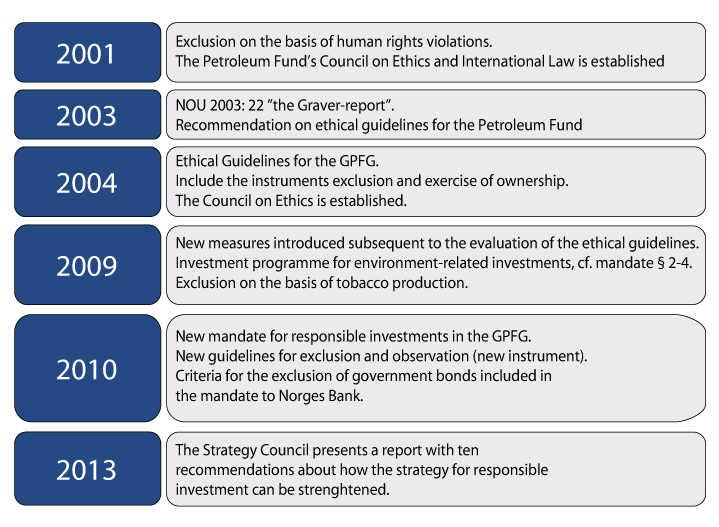
Figure 4.31 Development of the GPFG responsible investment strategy
Source Ministry of Finance.
The responsible investment strategy for the management of the Government Pension Fund currently encompasses the following areas:
international collaboration and contribution to the development of best practice;
environment-related investments;
research and analysis;
active ownership; and
observation and exclusion of companies on ethical grounds
Specific environment-related investment mandates were established as the result of the evaluation of the ethical guidelines. The investments are made within the same framework as governs the other investments of the Fund in equities and bonds. The performance of the environment-related mandates is discussed in more detail in section 4.1.6. See also section 2.6.
In January 2013, the Strategy Council was requested to prepare a report addressing the overarching responsible investment strategy for the GPFG. The report was submitted on 11 November 2013 and circulated for consultation on 29 November 2013. The Strategy Council made a number of suggestions for the further strengthening of responsible investment practice. The report, the consultative comments and the Ministry’s assessments are discussed in section 2.5.
The Ministry of Finance, Norges Bank, Folketrygdfondet and the Council on Ethics all participate in the international responsible investment debate and collaborate with others in promoting the development of practices and research within their areas. This type of collaboration is useful because it can contribute to the development and clarification of international practice, whilst at the same time proving a basis for refining the Fund’s own strategy.
Norges Bank and Folketrygdfondet have defined their own active ownership principles for the GPFG and the GPFN, respectively, on the basis of internationally recognised principles, cf. box 4.2.
Textbox 4.2 Basic active ownership principles
Norges Bank and Folketrygdfondet exercise the ownership rights of the GPFG and the GPFN, respectively. The mandate from the Ministry stipulates that active ownership shall be based on the UN Global Compact, the OECD Principles of Corporate Governance and the OECD Guidelines for Multinational Enterprises. These principles and standards are voluntary and non-legal recommendations expressing good corporate governance expectations and impose requirements concerning responsible corporate environmental and social practices. Norges Bank and Folketrygdfondet have prepared their own governance documents for responsible investment. These specify how such considerations are integrated in the investment activities and in company follow-up. In 2006, the UN published a set of Principles for Responsible Investment (PRI). The Ministry of Finance, Norges Bank and Folketrygdfondet have all signed up to the PRI on behalf of the GPFG and the GPFN. The PRI are based on the premise that environmental, social and corporate governance considerations affect financial returns.
UN Global Compact
The UN Global Compact defines ten universal principles derived from the Universal Declaration of Human Rights, the ILO Declaration on Fundamental Principles and Rights at Work and the Rio Declaration on Environment and Development. The principles are general in nature and state, inter alia, that businesses should respect human rights and not be complicit in human rights violations, should uphold the freedom of association and collective bargaining, and eliminate all forms of forced and compulsory labour, child labour and discrimination with respect to employment and occupation. Furthermore, businesses should support a precautionary approach to environmental challenges, promote greater environmental responsibility and the development and diffusion of environmentally friendly technologies, and combat all forms of corruption, including extortion and bribery.
The main objective of the Global Compact is to integrate the ten principles in the business operations of enterprises worldwide, as well as to promote activities and partnerships that contribute to the realisation of the UN objective of sustainable development.
Joining the Global Compact means that an enterprise seeks to observe the ten principles. The Global Compact is currently the world’s largest corporate social responsibility initiative, with close to 10,000 participants, including more than 7,000 corporate participants, from more than 130 countries. Participants report annually on their implementation of the principles. Findings are published in an annual Global Corporate Sustainability Report.
OECD Principles of Corporate Governance
These principles mainly address the basis for effective corporate governance, including the rights of shareholders and key ownership functions, equitable treatment of shareholders, transparency and disclosure, as well as the responsibilities and liabilities of boards of directors. The guidelines state, inter alia, that it is an important board responsibility to oversee systems designed to ensure that companies comply with applicable laws, including tax, competition, labour, equal opportunities, health and safety laws. The guidelines also state that boards must be able to exercise objective and independent judgment in order to effectively fulfil their responsibilities.
OECD Guidelines for Multinational Enterprises
The OECD Guidelines for Multinational Enterprises are voluntary and non-legal recommendations from state parties to companies engaged in international business activities. The voluntary nature of the guidelines implies that there are no compliance requirements in the legal sense. However, companies are expected to adhere to the guidelines to the extent applicable to each business. Companies must themselves decide how to do so in the most appropriate manner. The guidelines were amended in 2011, which amendments included adding a chapter on human rights. The new guidelines call on enterprises to avoid causing or contributing to negative impacts through their own business operations or through business relationships. Guidance is also provided on how companies should follow up their supply chains.
The new guidelines also call on companies to observe the due diligence principle. Labour rights have also been strengthened and updated in line with the ILO Tripartite Declaration of Principles concerning Multinational Enterprises and Social Policy. Companies are advised to adopt a precautionary approach to most issues addressed by the guidelines. See section 4.4.3 for further details.
Principles for Responsible Investment (PRI)
The PRI is an initiative supported by the UN Environment Programme Finance Initiative (UNEP FI) and the UN Global Compact. The initiative is aimed at asset owners, asset managers and their professional cooperation partners. The principles provide, inter alia, guidance on how to take environmental, social and corporate governance issues into account in asset management and active ownership. Incorporation of such issues will also influence what type of information investors request from businesses and what businesses are expected to report on. The PRI currently has about 1,200 members, of which about 270 are asset owners, 780 are asset managers and 180 are financial service providers. Norges Bank contributed to the formulation of the principles. The Ministry of Finance reports to PRI on application of the principles in the management of the GPFG and the GPFN based on, inter alia, feedback from Norges Bank and Folketrygdfondet, respectively. PRI reporting has been under revision in recent years, and the Ministry reported for the first time under the new reporting model in March 2014. The Ministry has also contributed in test reporting during the revision phase.
Active ownership is a key tool in the management of the Government Pension Fund. Both Norges Bank and Folketrygdfondet have, in line with international developments, expanded and developed their active ownership. The interaction between active ownership and asset management in general has been strengthened. The active ownership of Norges Bank and Folketrygdfondet is discussed in sections 4.4.2 and 4.4.3.
Companies shall be excluded from the Fund if they produce certain products. Companies may also be excluded if there is an unacceptable risk that they contribute to, or are themselves responsible for, grossly unethical activities as defined in the guidelines. Exclusion of companies is a tool reserved for special cases. Observation may be used in case of doubt as to whether the exclusion criteria are met, in case of doubt as to future developments, or if deemed appropriate for other reasons. Whether to place a company under observation is decided by reference to the specific exclusion criteria in the guidelines.
The role of the Council on Ethics in the observation and exclusion of companies from the GPFG is discussed in section 4.4.4.
The investments of the Fund in coal companies and other companies that produce fossil fuels have been debated in 2013. The Ministry discusses the follow-up of this debate in section 2.7. The Ministry discusses some ongoing processes on international corporate social responsibility guidelines in section 4.3.
4.5.2 Responsible investment and active ownership in the GPFG
It follows from the mandate laid down by the Ministry of Finance that Norges Bank shall integrate environmental, social and corporate governance considerations, based on internationally recognised responsible investment principles and standards, in all its investment activities. Hence, the Bank has adopted responsible investment principles and guidelines. These represent the framework for responsible investment, including active ownership provisions. The guidelines are published on the Norges Bank website (see www.nbim.no/en). The guidelines stipulate, inter alia, that environmental, social and corporate governance information shall form part of the basis for the Bank’s investment decisions and risk management.
Section 2.5 of this report proposes the integration of the responsible investment tools in Norges Bank. This implies, inter alia, that Norges Bank will also be responsible for excluding companies based on criteria laid down by the Ministry of Finance. The discussion below reports on the responsible investment role of the Bank thus far.
Norges Bank’s responsible investment guidelines require the Bank to premise its active ownership on predictability, transparency and compatibility with the long-term investment strategy for the Fund. Norges Bank uses its shareholder rights to promote social and environmental considerations and contribute to improved corporate governance standards. The Bank is in contact with companies, investors and authorities. It also maintains a dialogue with other parties involved in establishing financial market standards.
Focus areas for active ownership
At yearend 2013, the GPFG equity holdings represent an average ownership stake of 1.3 percent in more than 7,000 companies included in the benchmark index of the Fund. Although its ownership stakes are relatively low, the Fund is amongst the main shareholders of a number of companies. Norges Bank emphasises that it is therefore often better positioned to influence markets and individual companies than are many other investors.
Norges Bank bases active ownership on the UN Global Compact, the OECD Principles of Corporate Governance and the OECD Guidelines for Multinational Enterprises (see box 4.2). The Bank has defined certain active ownership priorities, and has thus far chosen six strategic areas:
equal treatment of shareholders;
roles and responsibilities of the board;
well-functioning financial markets;
children’s rights;
climate change; and
water management
Integration of environmental, social and corporate governance considerations
Norges Bank premises its active ownership on established corporate governance principles and practices, which imply that responsibility for the business strategy and operations of a company lies with its board of directors and its managers. The board of directors is accountable to all shareholders, and should be familiar with the general views of leading shareholders without discriminating or according undue influence to special interests. Norges Bank states, in its annual report on the management of the GPFG in 2013, that its investment analysis includes analyses of countries, markets and companies, including risk assessments of environmental, social and corporate governance issues. Norges Bank notes that it has a long-term commitment to the defined strategic focus areas. The active ownership tools are dialogue with companies, investors, regulatory bodies and other standard setters. Moreover, the Bank votes in general meetings and submits shareholder proposals. Some of the tools, such as dialogue with standard setters, will, according to Norges Bank have an impact on all or major parts of the fund portfolio. Other activities, such as company engagement, may impact on individual companies. Priority is accorded to the follow-up of the companies in which the Fund has its largest holdings. Such holdings are the most important in terms of the overall risk and return on the Fund.
Norges Bank states, in its consultative comments on the report of the Strategy Council (cf. the discussion in section 2.5) that environmental, social and corporate governance considerations are integrated in the investment process and in risk management, which may result in portfolio modifications, divestment decisions or decisions to refrain from acquiring certain securities. The Bank states, in its annual report on the management of the GPFG in 2013, that it continued to adapt the portfolio to environmental and social risks that may have an impact on the return on the Fund. The portfolio modifications were based on sector and company analyses intended to identify business models that are held to be less sustainable and profitable over time. Last year, Norges Bank performed a risk assessment of sectors that pose particular environmental challenges. The Bank divested its holdings in 27 companies as the result of such risk assessments. These divestments encompassed 11 coal-mining companies and 16 gold-mining companies.
Furthermore, the Bank states in its consultative comments that there are positive interactions between the various active ownership tools and the other investment activities. In its active ownership, the Bank analyses and accumulates knowledge about issues that may be of relevance to long-term company returns. Environmental, social and corporate governance issues may have an impact on investment risks and returns. Correspondingly, knowledge accumulated as a basis for investment decisions may benefit active ownership. The Bank meets representatives of the companies in which the Fund is invested, on a regular basis, through its investment activities. This lays the foundations for a good dialogue on ownership issues. Moreover, the Bank accumulates, through the investment activities, very considerable knowledge about many of the companies in which the Fund is invested. Such knowledge contributes to ensuring that its active ownership activities are relevant and premised on a comprehensive understanding of individual companies and issues. This may, according to the Bank, improve the scope for positive results from active ownership.
Voting, shareholder proposals and participation on governing bodies
In its active ownership prioritisation, Norges Bank takes the composition of the Fund portfolio into account. The Bank has experienced that it is especially important to consider active ownership and investment decisions in the context of each other in companies where the Fund is a major owner. The Bank also takes into account whether an issue can be said to be of material importance at the company level, and whether it may have an impact on the valuation of the company. The dialogue with companies becomes more consistent when active ownership is considered in the context of investment decisions. The Bank states, in its annual report on the GPFG, that voting is the most important formal avenue for investors to express views, keep company boards accountable and influence companies. In 2013, Norges Bank established a Corporate Governance Advisory Board to strengthen long-term active ownership. The Board consists of three experts of international repute who provide input on the board nomination and selection practices of the listed companies invested in by the Fund. In addition, it serves as an active ownership advisory body. The Board will provide input for the ownership involvement of the Fund regarding global standards on an ongoing basis.
Norges Bank states, in its annual report on the GPFG in 2013, that it voted in 9,583 general meetings. As from the third quarter of 2013, the voting is published on the Norges Bank website on the day after the votes are cast. Norges Bank states that it considered and voted on, inter alia, 239 shareholder proposals on environmental and social issues during the year, in line with the active ownership principles of the Bank. Moreover, the Bank submitted shareholder proposals with four US companies to give shareholders the right to nominate directors on the proxy ballot distributed with the notice of general meeting (“proxy access”). The shareholder proposals were submitted to draw attention to board accountability and to shareholder rights, in line with the corporate governance focus areas of the Bank. In its annual report, the Bank states that about one third of the shareholders of three of these companies voted in favour of the shareholder proposals. The shareholder proposal submitted with the fourth company was withdrawn when the company itself adopted a similar expansion of shareholder rights, prior to the general meeting.
The Bank states that 2,304 meetings were held between Fund representatives and company executives during 2013. In these meetings, Norges Bank addressed the plans, strategies and financial positions of companies, including environmental, social and corporate governance issues. The Bank also held 77 meetings with the chairperson of the board of companies in which the Fund holds large ownership stakes. The meetings covered a wide range of ownership issues, focused on the role of the board in establishing and developing an effective corporate governance framework.
In the first quarter of 2013, Norges Bank exercised its right to nominate a representative for the election committee of Volvo AB. This was the first time Norges Bank exercised its right to sit on the election committee of a company. The Bank states that such nomination is in line with its long-term intention of closer contact with company boards in order to safeguard the Fund assets. The CEO of Norges Bank Investment Management, Yngve Slyngstad, represented Norges Bank on the election committee.
Children’s rights, climate change and water management
Norges Bank expects companies to handle social and environmental risks that may have a negative impact on the Fund’s investments. The Bank has accorded priority to placing a focus on risks relating to children’s rights, climate change and scarce water resources. The Bank has prepared separate expectation documents for these areas, cf. above. In 2013, the Bank charted how companies in particularly exposed sectors met its expectations. Such reviews are based on publicly available information from the companies. The most comprehensive review concerned climate-related risk. As far as children’s rights are concerned, the main conclusion of the Bank in 2013 was that one had noted a general increase in reporting in all relevant sectors, and especially within clothing production. The Bank states that findings are more mixed for water management, and that companies generally provided limited reporting on the extent to which water management strategies and plans were implemented.
Children’s rights
Norges Bank expects companies to safeguard children’s rights in their own businesses and those of their suppliers. Companies need to demonstrate that they have adequate systems in place to handle the risk of violating children’s rights. In its annual report, Norges Bank states that it continued to support the implementation of the UNICEF principles on children and corporate social responsibility in 2013, as a member of a working group advising UNICEF. The working group advises UNICEF on how companies can implement the principles. The principles were launched in March 2012 by UNICEF, the UN Global Compact and Save the Children.
Climate change
Norges Bank expects companies to develop strategies for handling climate change risk and report on what they do to reduce the risk that such changes may have a negative impact on profitability. In 2012, Norges Bank expanded its expectations in this area to also include tropical deforestation risk. In its annual report, the Bank states that data from CDP were used directly in examining reporting within strategic focus areas with effect from 2013. Norges Bank supports the CDP initiative to standardise and expand global climate risk reporting.
Water management
Limited access to freshwater is an increasing risk for many companies. In its annual report, the Bank states that such risk may represent a long-term financial risk for companies whose business models are vulnerable in terms of access to freshwater. In 2013, the Bank continued its involvement with the CDP Water Disclosure initiative, which seeks to improve water resource information. Norges Bank would like information that enhances investors’ understanding of water-related risks in exposed sectors and improved information coverage in emerging markets. Norges Bank has been main sponsor of the CDP Water Disclosure initiative since 2009. A survey from 2013 amongst senior executives and experts from business, government and non-governmental organisations under the auspices of the World Economic Forum showed that a water-related crisis is believed to be one of the most likely global threats.
Industry collaboration and the development of standards
In 2013, Norges Bank supported the development of international standards by, inter alia, making recommendations to the International Integrated Reporting Council (IIRC). Integrated corporate reporting enhances the quality of the information disclosed to investors, especially in relation to environmental, social and corporate governance matters.
4.5.3 Responsible investment and active ownership in the Government Pension Fund Norway
It follows from the mandate laid down by the Ministry of Finance that Folketrygdfondet shall integrate environmental, social and corporate governance considerations, based on internationally recognised responsible investment principles, in all its investment activities. The Board of Directors of Folketrygdfondet has adopted responsible investment principles based on the “Norwegian Code of Practice for Corporate Governance“ (NUES), the UN PRI and the OECD Principles of Corporate Governance. These principles define a general framework for how Folketrygdfondet shall deal with environmental, social and corporate governance issues in seeking to maximize returns over time. Folketrygdfondet has also published a separate document on its active ownership (see www ftf.no).
Focus areas for active ownership
Folketrygdfondet is of the view that active company follow-up contributes to both lower risk and good portfolio returns over time.
As a financial investor, Folketrygdfondet gets involved in ownership issues like board composition, remuneration, reporting and communication, values and governance principles, as well as capital structure and strategy. Folketrygdfondet also deems it important to monitor the executive salary policies of companies for purposes of safeguarding shareholder value.
In line with the mandate laid down by the Ministry, Folketrygdfondet keeps companies accountable for their handling of environmental, social and corporate governance issues. In order to clearly communicate its expectations, Folketrygdfondet has prepared guidance notes for companies’ handling of executive salary schemes, human rights, labour rights, the environment and anti-corruption. The guidance notes shall illustrate what guidelines Folketrygdfondet expects companies to adopt, as well as how it expects companies to follow up and report on each issue.
The guidance notes are anchored in the responsible investment principles of Folketrygdfondet and based on the UN Global Compact and NUES. Folketrygdfondet’s guidance notes on ownership issues and social considerations are available on the Folketrygdfondet website (www.ftf.no).
Integration of environmental, social and corporate governance considerations
The responsible investment principles of Folketrygdfondet apply to all companies in which the GPFN is invested. However, different methods are used in the follow-up of the various sub-portfolios. In 2012, Folketrygdfondet prepared the document “Folketrygdfondet’s active ownership”, presenting its active ownership of Norwegian and Nordic companies. The document is available on the Folketrygdfondet website (www.ftf.no).
Folketrygdfondet has integrated responsible investment considerations in both its investment activities and its follow-up of individual companies.
Folketrygdfondet has invested in some sectors that pose special environmental, social and corporate governance (ESG) challenges. Folketrygdfondet has, as a risk management tool, prepared ESG analyses for each of the companies in the Norwegian portfolio. Such analyses form the basis for individual company follow-up. Folketrygdfondet has, against this background, defined certain focus areas.
In 2013, Folketrygdfondet focused on companies’ greenhouse gas emissions and associated reporting, their human rights and labour rights involvement, as well as their anti-corruption activities. Folketrygdfondet also continues its focus on unconventional oil and gas extraction.
Company dialogue is an important active ownership component in the management of the Norwegian investment portfolio. In the Norwegian market, Folketrygdfondet holds meetings and maintains contact with company executives. This may include meetings with the chairperson of the board on matters that fall within the responsibilities of the board of directors. Folketrygdfondet is committed to pursuing a good governance and social responsibility dialogue with companies. This implies, inter alia, that Folketrygdfondet raises relevant environmental, social or corporate governance issues with company executives. In its ownership report for 2013, Folketrygdfondet states that it has been pursuing a dialogue with 17 companies in Norway on key ownership issues and specific incidents. This is in addition to its ongoing contact with companies as part of its asset management.
CO2 analysis of the portfolio
In 2013, Folketrygdfondet commissioned a CO2 analysis of the Norwegian equity portfolio to enhance its understanding of climate risk in the portfolio. The analysis of the Norwegian equity portfolio was conducted by the British consulting firm Trucost. The analysis concludes that the companies invested in by Folketrygdfondet within the materials, energy, manufacturing and consumer goods sectors make the main contributions to the overall CO2 emissions of the portfolio companies. Folketrygdfondet uses company dialogue to ensure that companies are conscious of their own climate risk, and have strategies and tools for managing such risk.
Enhanced follow-up of the Nordic portfolio and the fixed income portfolios
During 2012 and 2013, Folketrygdfondet has evolved its active ownership of the Nordic equity portfolio and the fixed income portfolios. The Fund has, inter alia, concluded an agreement with an external service provider on assistance with preparing analyses and pursuing dialogues with portfolio companies if incidents that require follow-up are uncovered. Consequently, all investments of Folketrygdfondet are subject to continual monitoring. In its ownership report for 2013, Folketrygdfondet states that the external service provider pursued a dialogue with nine Nordic companies in the first half of that year.
In addition to continual monitoring of the fixed income portfolio issuers, Folketrygdfondet aims to further integrate ESG analyses in its ongoing credit evaluation. It is emphasised that an issuer’s handling of environmental and social matters is relevant for credit risk assessment purposes. If such an approach becomes more widespread amongst investors, this may over time have an impact on the financial costs of companies. For investments in equities and bonds issued by Nordic companies, Folketrygdfondet adheres to the decisions made by the Ministry of Finance on the basis of recommendations from the Council on Ethics for the GPFG. If the Ministry excludes Nordic companies from the GPFG investment universe, these are also excluded from the GPFN investment universe. The Ministry of Finance has established a procedure for notifying Folketrygdfondet of such decisions.
Voting and participation on governing bodies
Active participation in the general meetings of companies is another important aspect of Folketrygdfondet’s active ownership. Folketrygdfondet votes in the general meetings of all companies in which the GPFN holds shares as at the date of such general meetings. Votes were cast in 60 general meetings of companies listed on the Oslo Stock Exchange in 2013. Over that period, Folketrygdfondet voted against 17 proposals in the general meetings of 8 different companies. These proposals concerned, inter alia, executive salaries and option schemes.
For the Nordic portfolio, Folketrygdfondet has voted in a total of 111 general meetings in 2013, all by proxy with voting instructions. In the Nordic region, Folketrygdfondet has voted against 87 proposals submitted by company boards in the general meetings of 38 companies.
Election committees have in recent years become increasingly prominent governing bodies. According to Folketrygdfondet, directorships are being professionalised and board compositions with an appropriate mix of expertise for the company are deemed to be of major importance. Folketrygdfondet therefore emphasises the important role of election committees in composing competent boards. Folketrygdfondet is represented on seven election committees of Norwegian companies. In addition, it is represented on five corporate assemblies and eight shareholders’ committees.
Folketrygdfondet reports annually on its active ownership. In 2013, for the first time, its ownership report formed part of the annual report of Folketrygdfondet. The report describes which activities Folketrygdfondet has pursued to attend to its ownership interests. It includes, inter alia, specific discussion of some matters deliberated in general meetings, relevant matters raised by Folketrygdfondet with companies, as well as the number and types of appointments held by Folketrygdfondet employees on the governing bodies of companies.
Both voting explanations and the ownership report are available on the Folketrygdfondet website (www.ftf.no).
Industry collaboration and collaboration with other investors
Folketrygdfondet participates in several collaboration projects and initiatives to promote responsible investment. Folketrygdfondet deems participation in external initiatives to be important because it facilitates the exchange of information and experience with other investors. Folketrygdfondet also wishes to thus contribute to the development of relevant practices.
The GPFN and Folketrygdfondet have been signatories of the UN Principles for Responsible Investment (PRI) since 2008. Folketrygdfondet also participates in the Carbon Disclosure Project (CDP), which conducts an annual survey on corporate greenhouse gas emissions. Information gathered through the CDP is incorporated into the company analyses of Folketrygdfondet.
Folketrygdfondet participates actively in the Norwegian Institute of Directors, the Norwegian Society of Financial Analysts and the Eierforum group of institutional investors. Moreover, Folketrygdfondet was one of the driving forces behind the relaunch of the Norwegian Forum for Sustainable and Responsible Investments; Norsif, which was officially founded on 7 January 2013. Norsif is an association for asset owners, asset managers, service providers and trade associations engaged in activities in Norway. Norsif has a number of international sister organisations, also in the Scandinavian countries. As a professional forum, Norsif shall disseminate knowledge about, and contribute to the development of, responsible investment. Finance Norway (FNO) serves as the Norsif secretariat.
4.5.4 Observation and exclusion of companies
Under the guidelines of observation and exclusion from the GPFG’s investment universe, companies are to be excluded if they produce certain products or sell weapons to specific states. Companies may also be excluded if there is an unacceptable risk that they may contribute to, or are themselves responsible for, grossly unethical activities. The criteria for product-based and conduct-based exclusion, as well as a list of the companies excluded or placed under observation on the basis of these criteria, are available on the Ministry website (www.government.no/gpf).
The Council on Ethics regularly examines whether the grounds for exclusion of a company still apply. The Council may on the basis of new information recommend that the Ministry reverses an earlier exclusion or observation decision.
Since the previous report to the Storting on the management of the Government Pension Fund, the Ministry has announced that an additional 10 companies have been excluded from the Fund and that three companies shall be followed up by Norges Bank through active ownership. The observation of one company has been discontinued. Moreover, the grounds for exclusion have been amended in respect of two companies. 61 companies were excluded and two companies were under observation as of the end of March this year.
Product-based exclusion
The guidelines stipulate that the Fund assets shall not be invested in companies that, themselves or through entities they control:
Produce weapons that violate fundamental humanitarian principles through their normal use;
produce tobacco;
sell weapons or military material to states that are affected by investment restrictions on government bonds as described in Section 3-1, second paragraph, letter c, of the management mandate for the GPFG.
The Revised National Budget for 2004 provides an exhaustive list of weapons covered by the product-based exclusion criteria. The list includes chemical weapons, biological weapons, anti-personnel mines, undetectable fragmentation weapons, incendiary weapons, blinding laser weapons, cluster munitions and nuclear arms. The Fund shall not be invested in companies that develop or produce key components for these types of weapons.
The criterion for the exclusion of companies that produce tobacco is limited to the actual tobacco product and does not include associated products such as filters and flavour additives or the sale of tobacco products. All companies that, themselves or through entities they control, grow tobacco plants or process tobacco into end products shall be excluded regardless of how large or small a share such tobacco production represents of the company’s overall operations.
It follows from the mandate laid down by the Ministry of Finance for Norges Bank that the GPFG may in certain cases be prevented from investing in interest-bearing instruments issued by states. The Fund is not a foreign-policy tool, and it is only in special situations involving comprehensive international sanctions or other measures endorsed by Norway that such government bond investment restrictions can be implemented. The government bond exemption was introduced in 2010. Previously, the government bond exemption only applied to bonds issued by Myanmar. Since international sanctions and other measures change over time, it is appropriate to assess, on a regular basis, which states should be encompassed by the exemption, in view of which states are subjected to the most comprehensive sanctions and other measures. In January 2014, the Ministry of Finance performed such an assessment, based on information from the Ministry of Foreign Affairs regarding the scope of the sanctions and other restrictive measures adopted for individual states. The Ministry of Finance concluded that the exemption should no longer apply to Myanmar, whilst the exemption shall now be applied to North Korea, Syria and Iran. The international sanctions and other measures adopted against these countries include investment prohibitions implying that the GPFG cannot invest in such government bonds under any circumstance. Section 2, first paragraph, letter c, of the Guidelines for Observation and Exclusion stipulate that the fund assets shall not be invested in companies that:
“sell weapons or military material to states that are affected by investment restrictions on government bonds as described in Section 3-1, second paragraph, letter c, of the management mandate for the GPFG.”
The Council on Ethics will be following up on this provision in line with the changes announced by the Ministry of Finance with regard to the government bond exemption.
The Council on Ethics uses an external consultancy firm that continuously monitors the companies in the fund portfolio and the companies already excluded from the Fund for production in violation of the guidelines. The consultant reports to the Council on a quarterly basis on companies that may be engaged in such activities. In addition, the Council on Ethics collaborates with other financial institutions on a consultancy assignment to chart companies that produce cluster munitions.
The Council on Ethics will normally contact companies if there is reason to believe that these are engaged in production that violates the guidelines for the Fund. If companies confirm the information held by the Council, an exclusion recommendation is issued by the Council. Companies that fail to respond to the communication will be recommended for exclusion if the documentation of the Council on Ethics shows that such companies are highly likely to make products encompassed by the exclusion criteria. The Council adheres to this procedure to achieve a reasonable degree of assurance that companies making products in violation of the guidelines are excluded from the Fund. However, there is no guarantee that all companies are captured by the Council’s monitoring system at any given time.
40 companies are excluded from the Fund under the product-based criteria. 18 of these companies have been excluded on the basis of production of weapons that violate fundamental humanitarian principles in their normal use, whilst 21 companies are excluded for producing tobacco.
Conduct-based exclusion
A company may be excluded from the Fund if there is an unacceptable risk that the company contributes to, or is itself responsible for:
Serious or systematic human rights violations, such as murder, torture, deprivation of liberty, forced labour, the worst forms of child labour and other child exploitation;
serious violations of individuals’ rights in situations of war or conflict;
severe environmental damage;
gross corruption;
other particularly serious violations of fundamental ethical norms
The Council on Ethics identifies companies for assessment through news monitoring, initiatives from special interest groups and systematic evaluation of problem areas. The Council uses, inter alia, an external consultancy firm that continuously identifies news concerning portfolio companies in multiple languages. The Council receives quarterly reports from the consultant. The Council on Ethics also reviews and examines communications from persons and organisations that request the Council to assess companies or specific issues.
The Council on Ethics also studies certain issues or sectors where it is particularly likely, in the view of the Council, that companies may be engaged in activities in contravention of the ethical guidelines. Such sector studies will normally be initiated by the Council appointing an expert within the area to map all companies in the portfolio engaged in a certain type of activity and to collect information about companies that may pursue activities that violate the guidelines. The Council evaluates, based on the consultancy report, which companies to examine in more detail. This evaluation takes into consideration, inter alia, the magnitude and seriousness of the norm violations, the connection between the companies and the norm violations and the likelihood of future norm violations.
Amongst the cases identified through news searches, external requests and sector studies, the Council on Ethics selects, for further investigation, those cases that appear to be the most serious. The Council on Ethics attaches weight to, inter alia, how serious the norm violations are, whether a company is accused of several counts of unethical conduct, whether it is likely that norm violations will continue, and the scope for documenting the conduct of which the company is accused. The intention is to identify companies where there is an unacceptable risk that violations of the ethical guidelines are taking place and that such violations are expected to continue.
In order to document alleged norm violations, the Council on Ethics makes extensive use of consultancy firms, researchers and non-governmental organisations based in the country where the violations of norms are alleged to be taking place. Such assignments may, for example, involve fieldwork and evaluation of available documentation. Since 2009, the Council on Ethics has had a framework agreement with a consultancy firm that assists in the detailed investigation of companies.
In 2010, the Council on Ethics decided to examine nine environmental issues. This has been continued by the Council on Ethics in 2013 in, inter alia, the following areas; oil production entailing major local pollution problems, certain types of mining activity where waste handling involves special risk, unlawful logging and other particularly damaging logging, unlawful fishing and other particularly damaging fishing activity, damaging dam projects, as well as activities with extensive consequences for particularly valuable areas of protection.
The Council on Ethics is continuously examining and monitoring violations of the exclusion criteria set out in the guidelines. Within human rights, the Council has in 2013 placed a special focus on labour rights in, inter alia, the electronics industry, agriculture and fisheries. The Council on Ethics has also taken a closer look at companies involved in oil extraction in Equatorial Guinea.
Under the corruption criterion, the Council on Ethics places a special focus on companies engaged in industries and countries that are, according to international rankings, especially exposed to corruption. Companies faced with credible corruption allegations are subjected to more detailed examination.
The Council on Ethics contacts companies at a relatively early stage in its examination of cases. Companies are requested to answer questions or to send specific documents to the Council. In 2013, the Council on Ethics contacted more than 40 companies. From time to time, companies request a meeting with the Council. In 2013, the Council met with 18 companies. The Council on Ethics attaches weight to obtaining information directly from companies, but also issues recommendations on companies that fail to respond to communications from the Council.
A total of 21 companies are excluded from the GPFG under the conduct-based criteria, and 13 of these companies are excluded because they are deemed to cause severe environmental damage. Three of the companies are excluded on the basis of contributions to serious or systematic human rights violations, whilst two companies are excluded on the basis of other particularly serious violations of fundamental ethical norms, and three are excluded on the basis of serious violations of individuals’ rights in situations of war or conflict.
Observation
One company is under observation pursuant to the gross corruption criterion. During the observation period, the Council on Ethics is monitoring, inter alia, how the company is developing its systems to prevent corruption, how the company is handling the investigation of past corruption incidents, and whether any new instances of corruption are alleged. The Ministry also has one company under confidential observation under the war and conflict criterion.
The Council on Ethics informs the Ministry on an annual basis about the status of the companies placed under observation, and makes a new recommendation on the companies in question after the observation period has been completed.